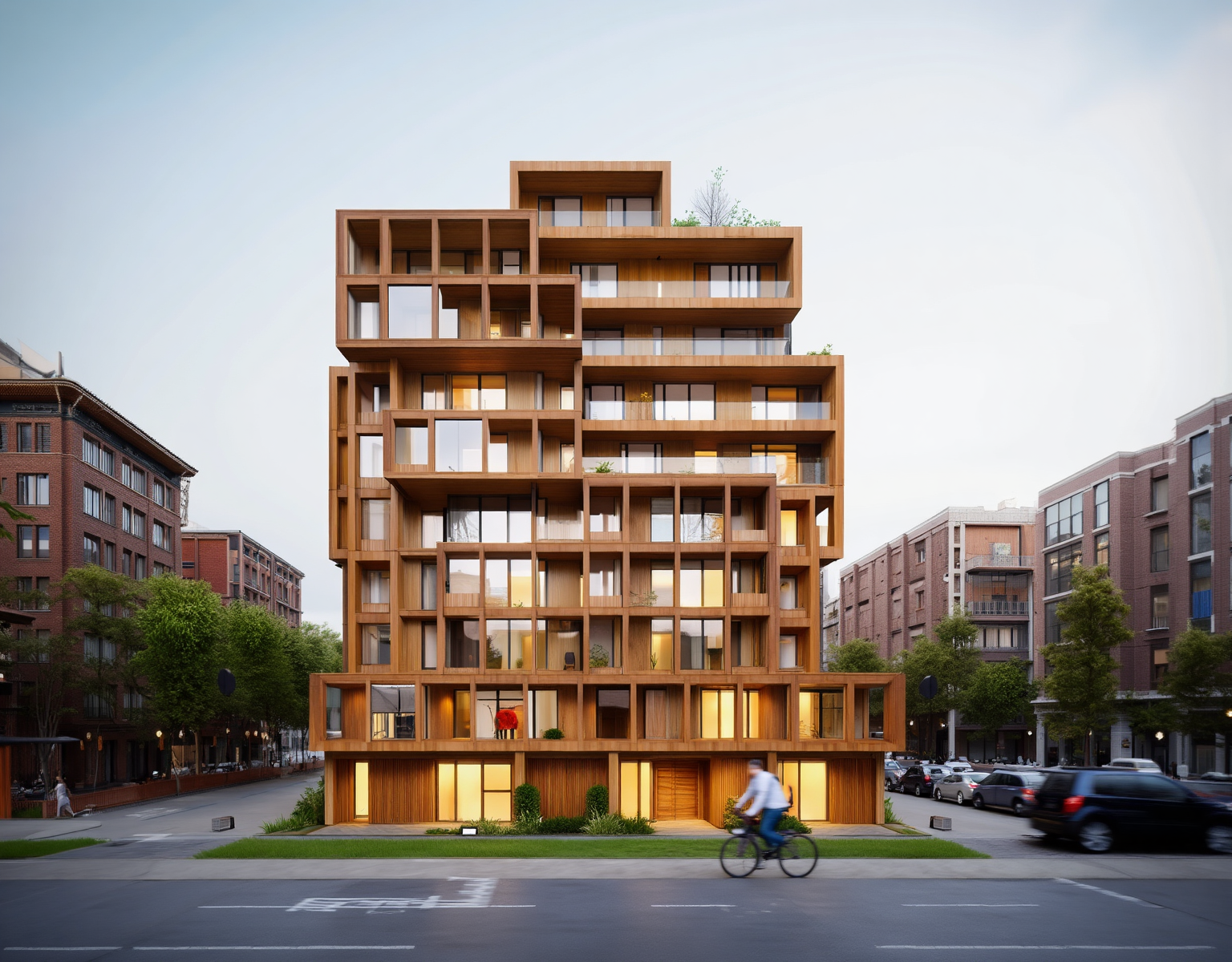
Abstract
As we advance into the 21st century, addressing the global housing crisis becomes imperative. By 2025, approximately 1.6 billion people will lack adequate housing, necessitating the construction of 96,000 affordable homes daily to meet the demand of 3 billion people by 2030 (Masterson, 2022). Urban areas, which now host over 50% of the world’s population, face the brunt of this crisis. Effective affordable housing strategies are essential, focusing on sustainable, resilient, and inclusive solutions (Habitat for Humanity, n.d.; World Green Building Council, 2022).
The housing crisis is exacerbated by several key challenges: a shortage of land, labour, and materials; financial constraints; and the increasing urban population leading to informal settlements. Traditional housing solutions are often unable to keep pace with these demands, making it crucial to adopt a novel, democratized, participatory design process. This approach empowers communities, enabling them to actively engage in and shape the development of their own housing.
Open-source architecture has become a powerful means of democratizing design, making it more accessible. Projects like Alejandro Aravena’s Elemental in Chile illustrate this potential, where residents complete “half-houses” as finances allow, reducing costs and promoting involvement (McKnight, 2016). Similarly, platforms like WikiHouse offer downloadable blueprints, enabling users to construct homes with minimal construction knowledge (Flynn, 2018). These initiatives highlight how open-source systems can address housing shortages by directly engaging communities in the building process.
Participatory design further enhances this by actively involving residents in shaping housing projects, ensuring their needs and preferences are met. Research shows that participatory design improves project relevance and acceptance, fostering ownership and community (Colistra and Vakil, 2020; Bukovszki et al., 2021). This approach results in better social, economic, and environmental outcomes by integrating local knowledge.
Emerging technologies offer a new way to scale these approaches. A proposed design tool could simplify participatory design, providing an easy-to-use interface for customizing housing while incorporating sustainability metrics. By leveraging computational design, the tool could optimize energy efficiency, adapt to local conditions, and create tailored housing solutions efficiently.
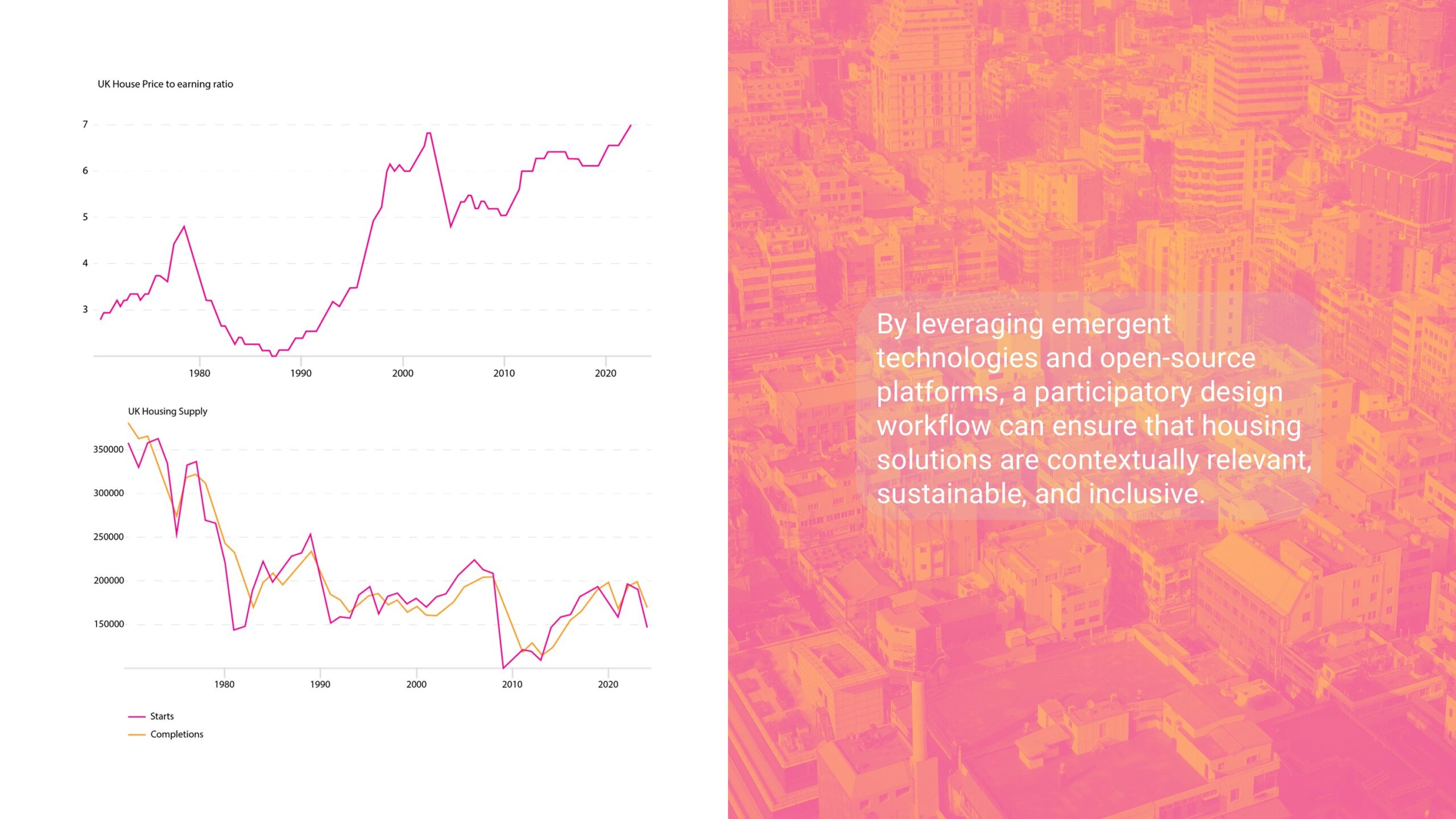
Problem and Hypothesis
We hypothesize that we can utilize powerful computational and parametric methods to do two key things:
- Automate context-based building generation utilizing field conditions, graph theory, and combinatorial modelling; simultaneously leverage top-down and bottom-up building generation techniques.
- Make the workflow readily available via a web-based app for end-users to rapidly develop feasibility studies as it relates to low-income housing.
Through tools such as Rhino3D and Grasshopper, we will develop a novel way for architects to embed their intuitive understanding of space into a generative design workflow. Rule-based grammar will inform unit and module creation while local field conditions given by environmental simulation and urban context facilitate the general building massing.
By applying our knowledge of various programming languages beyond the visual scripting of Grasshopper, the script will be deployed through a remote RhinoCompute server and made accessible via a Vue app. The four main problems we will address are:
Low-Income Modular Housing
The global affordable housing crisis is worsening, disproportionately affecting low-income individuals who face increased risks of homelessness and exclusion from essential services (United Nations, 2023). Prefabricated modular housing has gained traction as a solution, offering efficient, cost-effective construction through precision-engineered modules built off-site and quickly assembled (Meuser, 2020). While standardization improves affordability, it can lead to uniform, uninspiring environments. The challenge is to balance modular efficiency with flexibility, allowing for local adaptations and diversity in design (Robinson, 2006). Drawing inspiration from Japan’s Metabolism movement, which envisioned adaptable, evolving architecture, modern practices like Design for Manufacture and Assembly (DfMA) enhance modular systems by enabling easy assembly, disassembly, and adaptability over time. This approach reduces waste and supports sustainable, affordable housing solutions (Wilson, 2023).
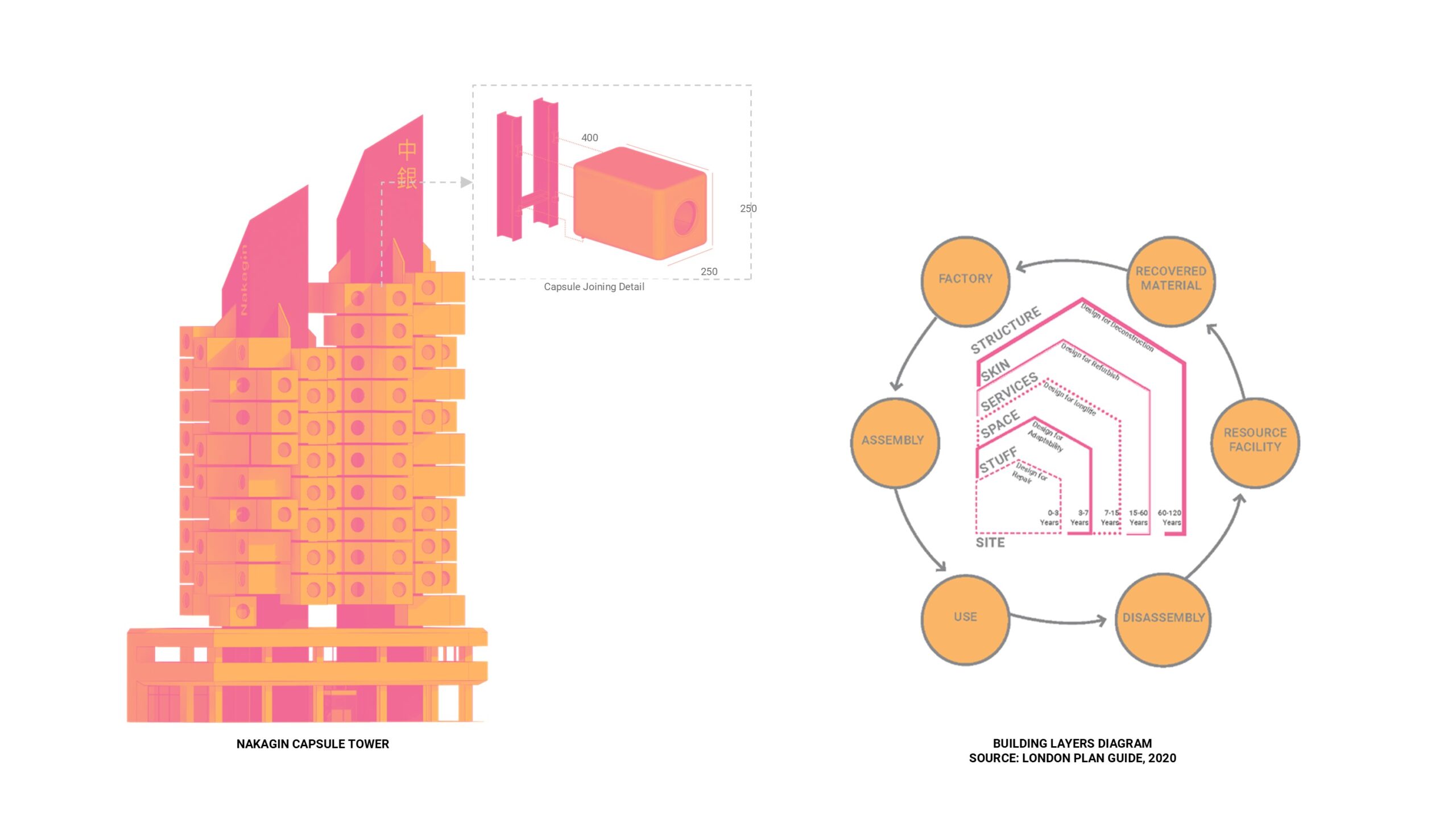
Participation and Digital Interfaces
Participatory design aims to involve residents in shaping their homes, but traditional methods often fall short, limiting residents to minimal influence (“Tokenism”) and leaving decision-making to policymakers and developers (Arnstein, 1969; Shah, 2018). Power imbalances, rigid regulations, and a lack of technical knowledge among residents further restrict meaningful participation (Brysch & Czischke, 2022).
Digital platforms are helping to overcome these challenges by making the design process accessible to non-experts. These tools simplify complex architectural concepts, enabling residents to co-create their living spaces without needing specialized knowledge. Through interactive features like simulations and real-time feedback, residents can engage more intuitively, visualizing and shaping their homes in ways that were previously inaccessible. This approach not only democratizes the design process but also fosters deeper, more meaningful community participation (Ng et al., 2023).
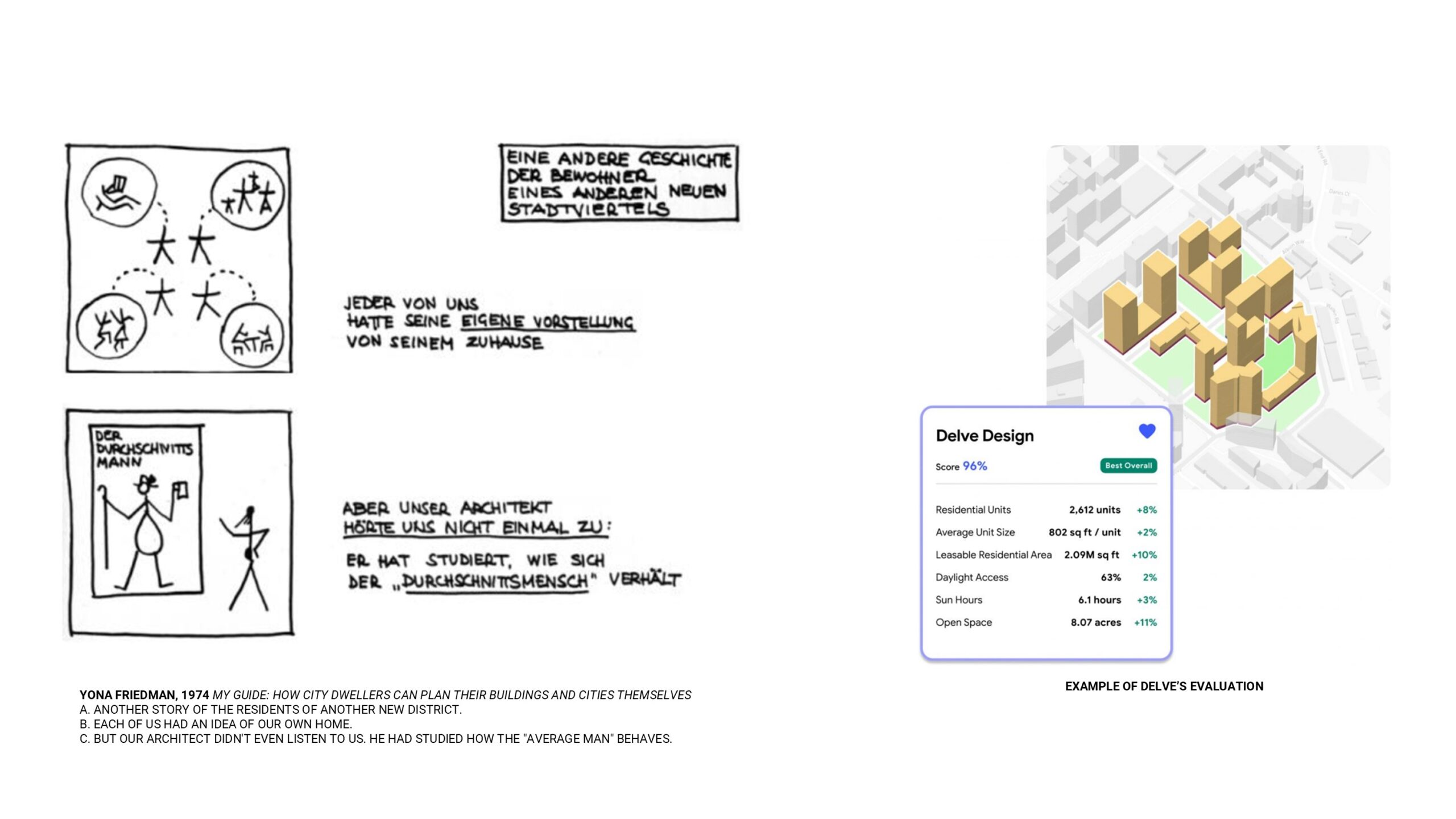
Environmental Simulation
In architecture, climatic considerations are often introduced too late, after key decisions on massing and orientation have been made. As noted by Bass et al. (2023), “to analyze a design, we need a design to analyze,” meaning early decisions are often guided by intuition or rules of thumb, with analysis tools only used to validate the final design. This delay is understandable given the need to balance client requirements, building codes, and diverse climates, but it limits the potential for optimizing environmental performance from the outset.
Introducing environmental design and simulation earlier in the process would ensure that daylighting, energy use, and other performance metrics are integrated into the initial conceptual stages. Advanced computational tools and machine learning methods like Universal Design Spaces and dynamic surrogate modelling can rapidly analyze early design decisions, although implementing these AI-driven workflows still requires expertise in data and coding, which remains a barrier for many designers (Hinkle et al., 2022).
Similarly, open-source architecture, which allows for publicly accessible and modifiable designs, faces challenges in adapting to local climates and environmental concerns. While open-source methods could potentially lower costs for housing, they must integrate sustainable design tools to ensure buildings are energy-efficient and comfortable. This includes using local materials, low-embodied carbon methods like mass timber, and leveraging both passive and active strategies for climate adaptation. Without these considerations, open-source architecture will struggle to meet the environmental demands of modern housing (Arora, 2019; Raymond, 2023).
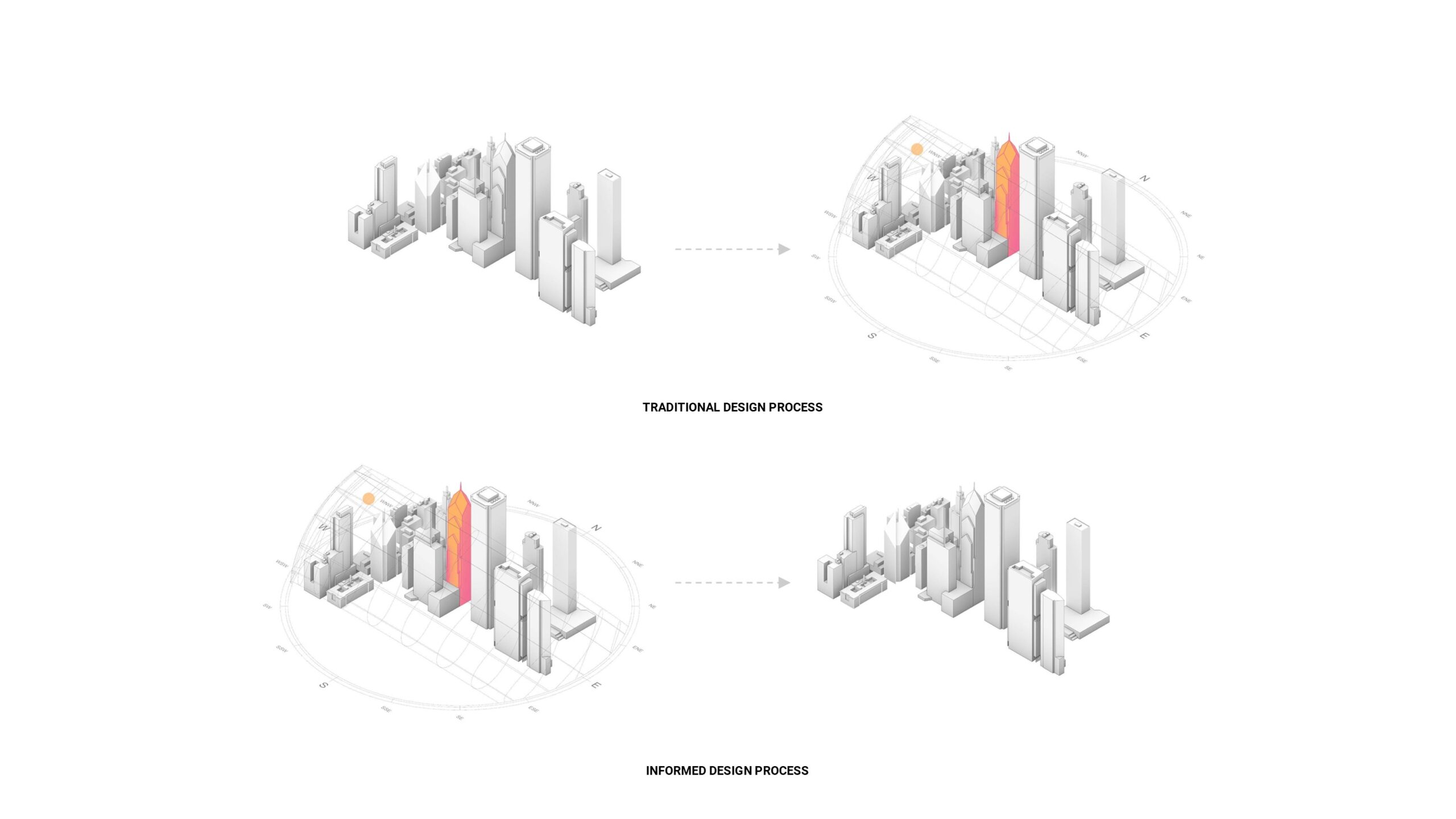
Building Generation and Graph Theory
Graph theory, a foundational mathematical discipline, is increasingly influential in architecture, particularly as data-driven approaches reshape design. It provides tools for analyzing spatial and social relationships, revealing how human interactions and movement are structured within buildings and urban environments. By abstracting spaces—such as rooms or plazas—into nodes and connections as edges, graph theory transforms these relationships into networks that map spatial and social dynamics (Chou, 2022). This approach moves beyond form, emphasizing the interconnected forces that shape architecture.
In generative design, graph theory facilitates a dynamic interaction between local conditions and broader strategies, allowing spatial elements to interact and create emergent properties (Hillier & Hanson, 1984). Tools like Space Syntax quantify spatial relationships by measuring integration and connectivity, showing how layouts impact behavior. High-integration spaces encourage social activity, while low-integration areas promote privacy (Hillier & Hanson, 1984; Myung et al., 2022). Incorporating Space Syntax into generative models allows architects to automate layouts while maintaining relational logic and spatial integrity (Chou, 2022).
A key advantage of graph theory and Space Syntax is their ability to encode the architect’s expertise into computational models. This ensures that critical spatial principles—such as connectivity, integration, and balance between public and private spaces—are maintained throughout the process, even without the architect’s constant presence. By embedding their design intelligence into algorithms, architects can indirectly guide the design, ensuring innovative, context-sensitive solutions emerge autonomously (Chaillou et al., 2020).
Metrics like centrality and clustering coefficients allow architects to balance spatial flow and density, as seen in projects like the New Carver Apartments and The Six, where these measures helped foster both community interaction and privacy (Myung et al., 2022). Ultimately, graph theory offers a synthesis of continuity and discreteness, helping architects explore relational yet distinct design solutions that reflect their expertise without requiring their direct involvement at every step.
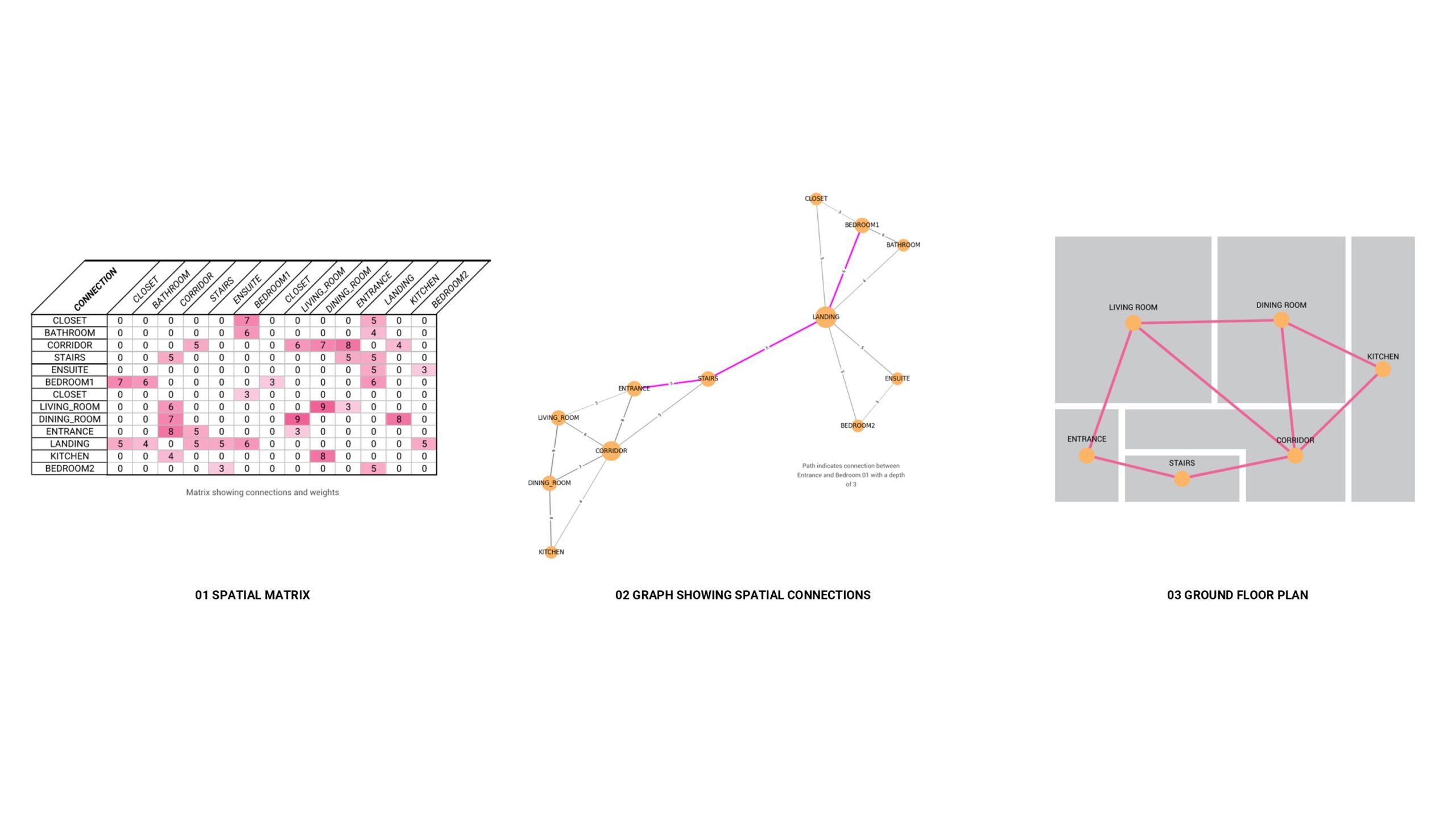
Research
Architectural Theory
The integration of computational and parametric methods has transformed architectural practice, leading to two contrasting theories: the continuous, fluid logic of parametricism and the discrete, object-focused approach of Object-Oriented Ontology (OOO). Parametricism, championed by architects like Zaha Hadid and Patrick Schumacher, draws inspiration from Gilles Deleuze and Felix Guattari’s concepts of “continuous variation” and “the fold.” Stan Allen’s notion of “field conditions” further articulates this perspective, viewing architecture as interconnected spaces defined by local relations rather than isolated objects (Allen, 1997; Allen, 2008).
Conversely, OOO, a branch of Speculative Realism, emphasizes the primacy of objects over relations. Architects such as David Ruy, Tom Wiscombe, and Mark Foster Gage advocate for designs composed of “discrete chunks” that engage directly without conforming to a totalizing field (Wiscombe, 2014). Graham Harman, the founder of OOO, posits that architecture should transcend both its compositional elements and its social and environmental context, involving both medium and mediators (Harman, 2022).
Our project seeks to synthesize these opposing approaches through Tristan Garcia’s “channels of being.” We interpret OOO as the substantial channel, expressed through parts, modules, and chunks within combinatorial modeling. Parametricism represents the vectorial channel, predicated on fields, rules, algorithms, and context. Garcia’s “thingly channel of being” underpins our workflow, moving beyond the duality of parametricism and OOO by considering a thing as “nothing more than the difference between that which is in this thing and that in which the thing is” (Garcia, 2010, p. 13).
We employ graph theory as the bridge between these perspectives. Utilizing nodes and edges, along with centrality metrics, allows us to design both from the top-down and bottom-up, expressing the duality between the internal composition of architecture and its external context. This methodology leverages computational methods to oscillate between field and object, as demonstrated in Adam Marcus’s figure drawing experiments, embracing the multiplicity of parts and emergent properties (Marcus, 2018).
By integrating graph theory into our workflow, we address real-world issues by making advanced theoretical and computational methods accessible to the public. This approach enables us to synthesize field conditions with an object-oriented ontology, developing a modular design that leverages both relational networks and the autonomy of individual parts. Nodes and edges in our models express this duality of ontologies, allowing us to celebrate emergent properties arising from local connections while maintaining the individuality of components.
In essence, our project embodies Garcia’s “thingly channel of being,” moving beyond the dichotomy of parametricism and OOO. By bridging these theoretical divides through graph theory, we offer a practical and nuanced approach to architectural design that is responsive, adaptable, and meaningful.

State-of-the-Art
One of the earliest examples of automatic floor plan generation is Cedric Price’s “Generator” from the late 1970s—a reconfigurable voxel-based spatial unit that allowed visitors to create different layouts. This pre-computational project envisioned modular, bottom-up floor plan design. Concurrently, George Stiny worked with building layouts using parametric shape grammars, and Christopher Alexander abstracted floor plans through relational graphs and tree structures, foundational ideas in today’s computational methods (Weber et al., 2022).
Automatic floor plan generation typically falls into three categories: bottom-up, top-down, and referential methods. Bottom-up methods utilize highly prescriptive spatial requirements from design briefs and relate to traditional practices like mind mapping and physical modelling. They facilitate rapid exploration of design variations and support modular construction, enabling robotic fabrication and reconfiguration. However, these methods may produce unfeasible designs and struggle with embedding hierarchical layers essential for circulation and structural load transfer (Weber et al., 2022).
Top-down methods are applied when projects have predefined constraints on the building envelope due to contextual requirements, site boundaries, and regulations. The initial massing is subdivided and optimized, adhering strictly to initial conditions. While effective within set boundaries, this approach is less practical for exploratory design where conditions are not well-defined (Weber et al., 2022). Multi-objective optimization tools like Galapagos and Wallacei X in Grasshopper help address specific architectural problems but are computationally intensive and often limit designer input during the solving process.
To overcome limitations of these methods, referential models employ databases and machine learning algorithms. Generative adversarial networks (GANs), such as House-GAN, have advanced AI in architecture but are often limited to single-story homes and lack coherence in three-dimensional building representation (Marcinkeviciute & Jabi, 2023). Building-GAN has introduced volumetric approaches using voxel space (Chang et al., 2021). Graph neural networks (GNNs) like Graph2Plan generate layouts based on user inputs but often produce low-resolution images that are difficult to scale. A significant research gap persists in generating complex, multi-story buildings with intricate room programs and solving circulation on multiple levels (Marcinkeviciute & Jabi, 2023).
Our project addresses these challenges by integrating graph theory into automatic floor plan generation, effectively bridging bottom-up and top-down approaches. By leveraging modular design and combinatorial modelling informed by graph theory, we aim to generate complex building layouts that incorporate multiple topological constraints, including comprehensive circulation systems. This method overcomes the limitations of current AI approaches, enabling the creation of feasible, scalable designs suitable for robotic fabrication and real-world application. Through this synthesis, we make advanced computational methods accessible to the public, contributing to the evolution of architectural design.
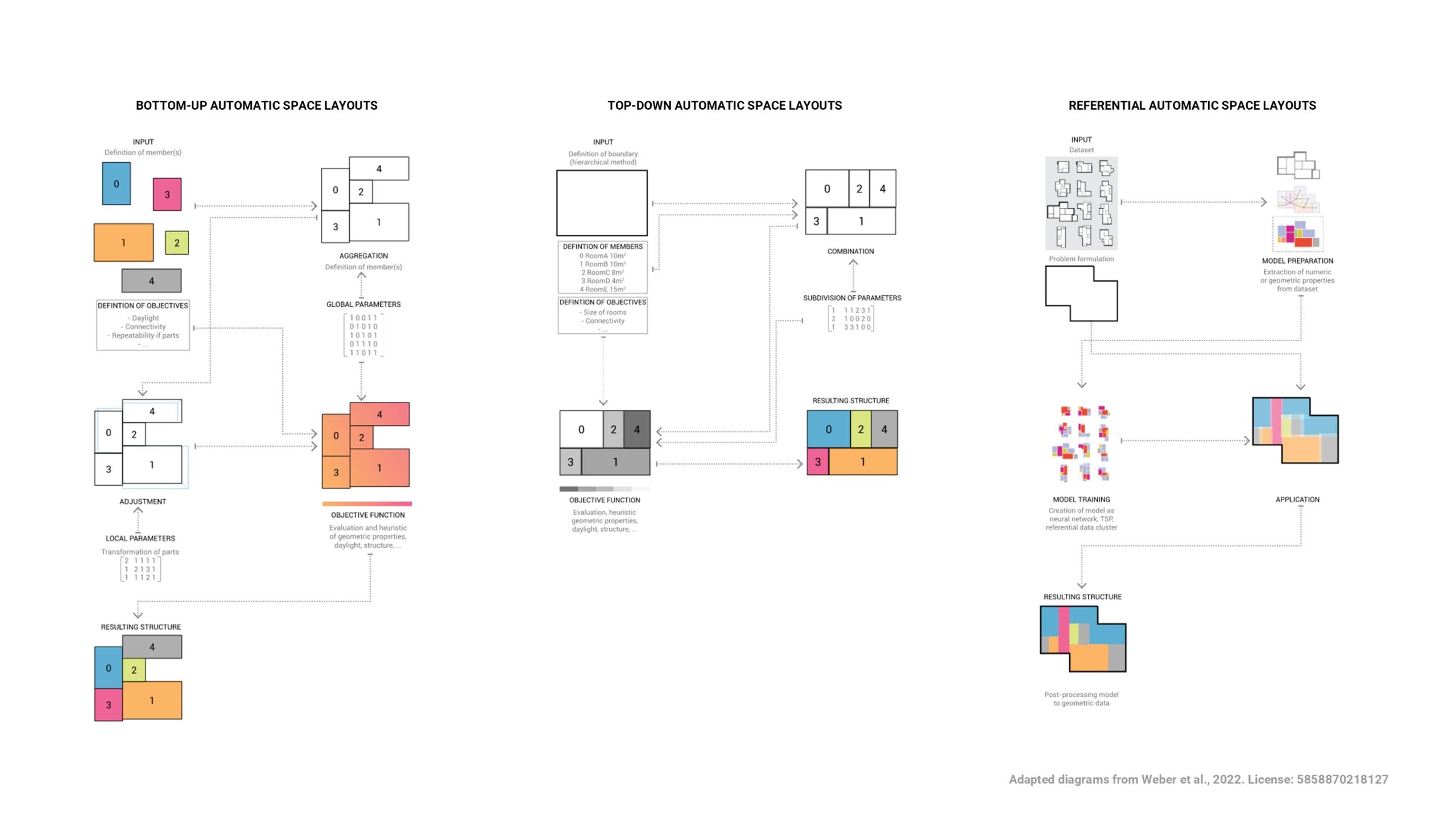
Methodology
Building on our research, we are exploring a hybrid approach for 3D building generation, emphasizing floor plan creation suitable for feasibility studies without delving into detailed subgraphs like doors or every programmatic room. While various machine learning (ML) strategies inspired aspects of our workflow, our focus is on developing a context-based, bespoke architectural modeling solution with embedded rules and climate-specific feedback. Although ML methods like synthetic data generation could enhance future developments—such as in post-processing techniques and graph-based room assignment—they were not the central focus of our current project.
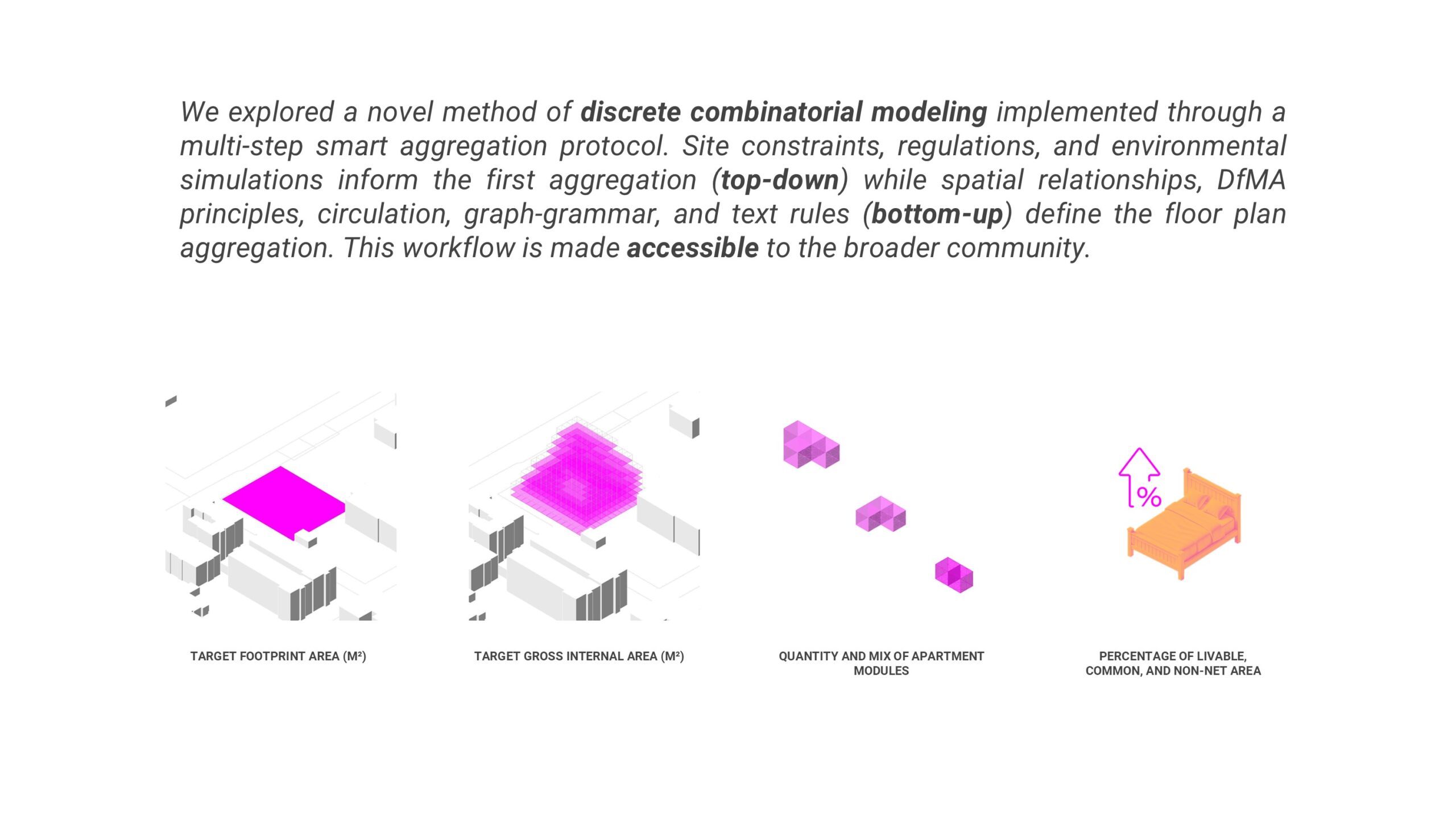
We utilized Rhino3D and Grasshopper, a visual scripting interface for Rhino, as our primary tools for geometry generation, data management, and visualization. After testing various aggregation methods over several weeks, we chose the Wasp plug-in by Andrea Rossi due to its balance of flexibility, robustness, and control (Rossi, 2023). Wasp allows for aggregations in any modelling coordinate system using a collision algorithm, without relying on a predefined slot system—making it more adaptable to diverse building sites selected by app users. This contrasts with tools like Monoceros, which require a predefined orthogonal grid and are less suitable for our needs.
The final component of our thesis involves making our computational method accessible through a web-based application. By integrating novel interfaces, we aim to engage non-expert stakeholders and the local community in the design process, making it more intuitive and collaborative. As noted by Weber et al. (2022), interactive approaches facilitate a better understanding of design requirements, leading to solutions that can negotiate between the needs of different stakeholders. These requirements pertain to programmatic changes based on environmental needs and internal space relations, which directly impact a building’s energy performance and space utilization rate.
Through this project, we demonstrate how advanced computational methods can be made accessible and practical for real-world applications, bridging the gap between complex architectural theories and user-friendly design tools.
Model Workflow
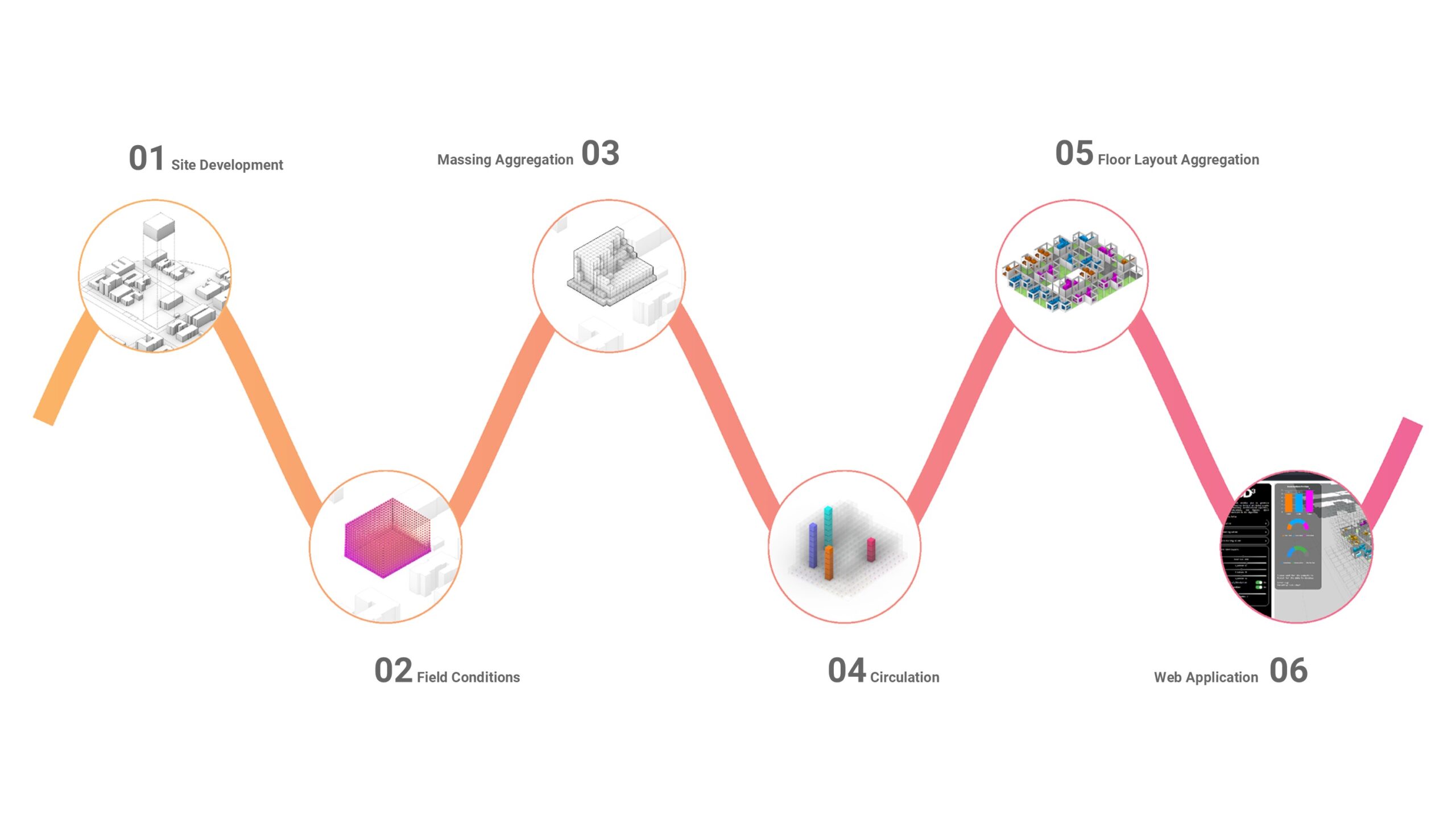
Site Development
The application pulls data from OpenStreetMap (OSM) to develop a site model (workflow shown to the right). OSM was chosen for its open-source nature, but it presents challenges like inconsistent formatting and missing data. To address these issues, error checking is essential, and a bespoke component was created to handle missing height information (Query GPT @ Food4Rhino). The average height is used in conjunction with the site footprint to provide the maximum development mass.
Another challenge is handling non-rectilinear sites, as our workflow requires a rectilinear development area that can be divided into a grid. To maximize the buildable area on any site, we explored the inscribed rectangle problem, which involves finding the largest rectangle that fits within a convex set while staying within the site’s boundaries defined by convex constraints (Chazelle, 1983; Behroozi, 2019).
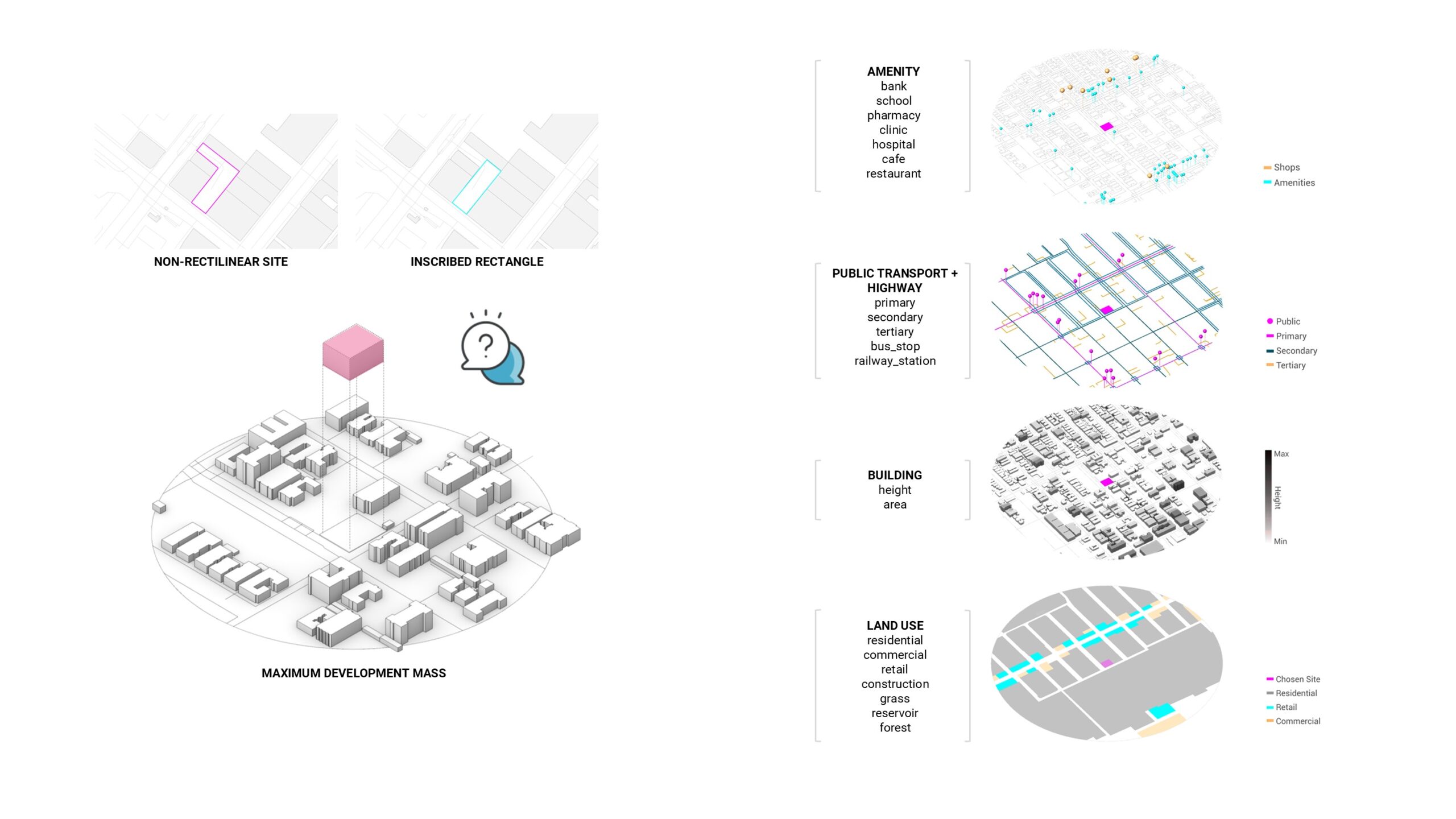
Structural Grid and System
A timber structural system combining wood and concrete offers a sustainable, efficient, and flexible building solution. Prefabricated timber-hybrid elements, such as slab panels and glulam columns, enable modular construction, reducing time, errors, noise, and costs while ensuring quality control. This system’s lightweight nature reduces foundation costs and supports building designs up to 30 stories, providing strength and adaptability for various uses like apartments or even offices. Timber systems are environmentally friendly, storing carbon and reducing emissions, making them a strong alternative to steel and concrete. They also offer fire safety through controlled charring and enhanced acoustic performance with integrated soundproofing. Designed for lifecycle sustainability, these systems support easy upgrades and recycling, minimizing environmental impact and maximizing flexibility over a building’s life.
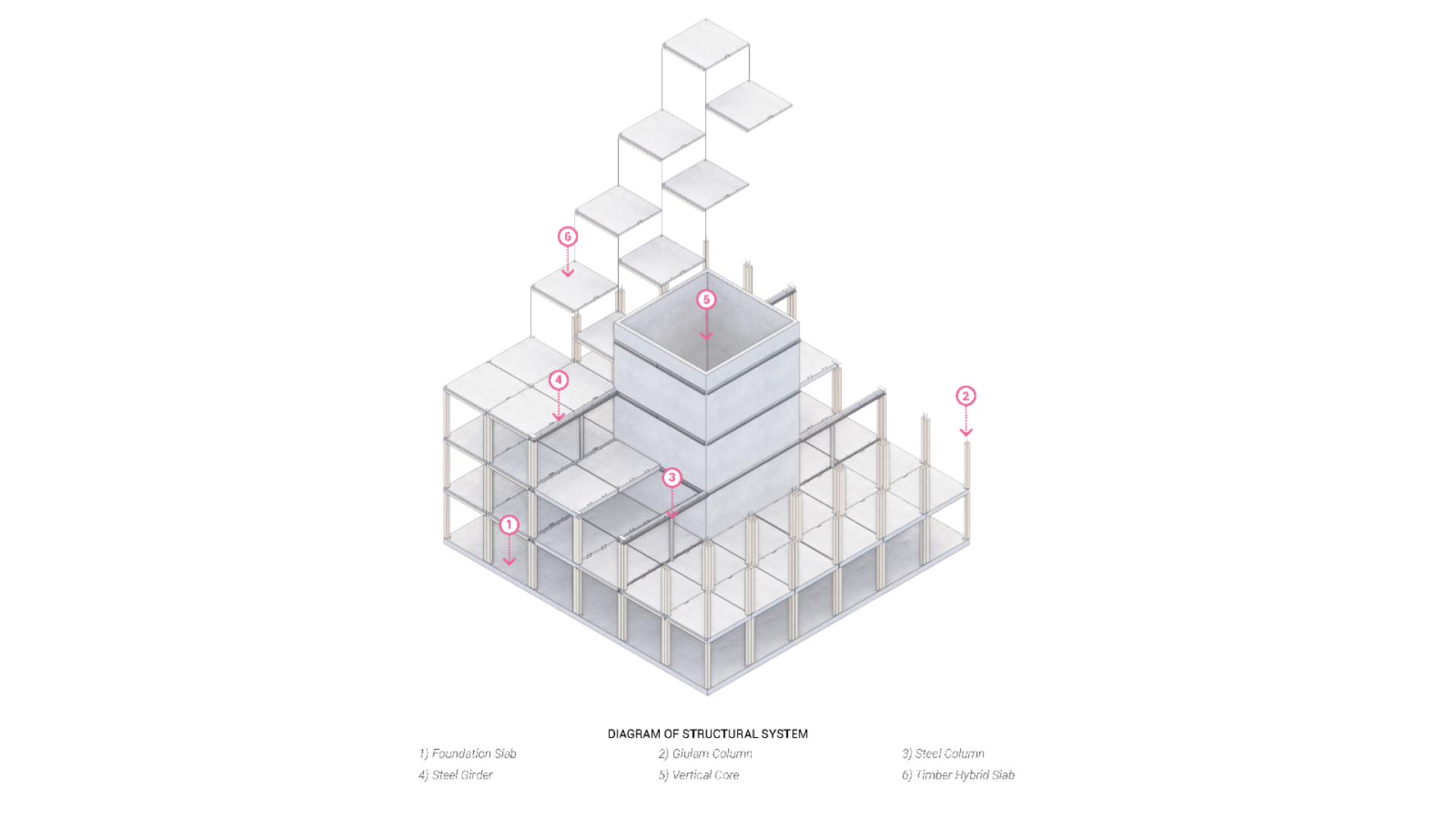
Module Typology
The modular design of these apartments, built with 3m x 3m units, provides a highly flexible, efficient, and sustainable solution for urban housing. By standardizing essential spaces such as kitchens, bathrooms, and living areas, this approach allows for rapid assembly, significantly reducing construction time, waste, and costs while maintaining high standards of quality and precision. Drawing inspiration from the “Interim London Housing Design Guide,” the apartments adhere to modern standards for space, accessibility, and sustainability, ensuring a comfortable and practical living environment. The modular system allows for varied layouts and adaptability to meet changing needs, enhancing the building’s long-term value. Additionally, this design promotes a community-centered approach, seamlessly integrating with the surrounding urban landscape and fostering a sense of connection among residents.
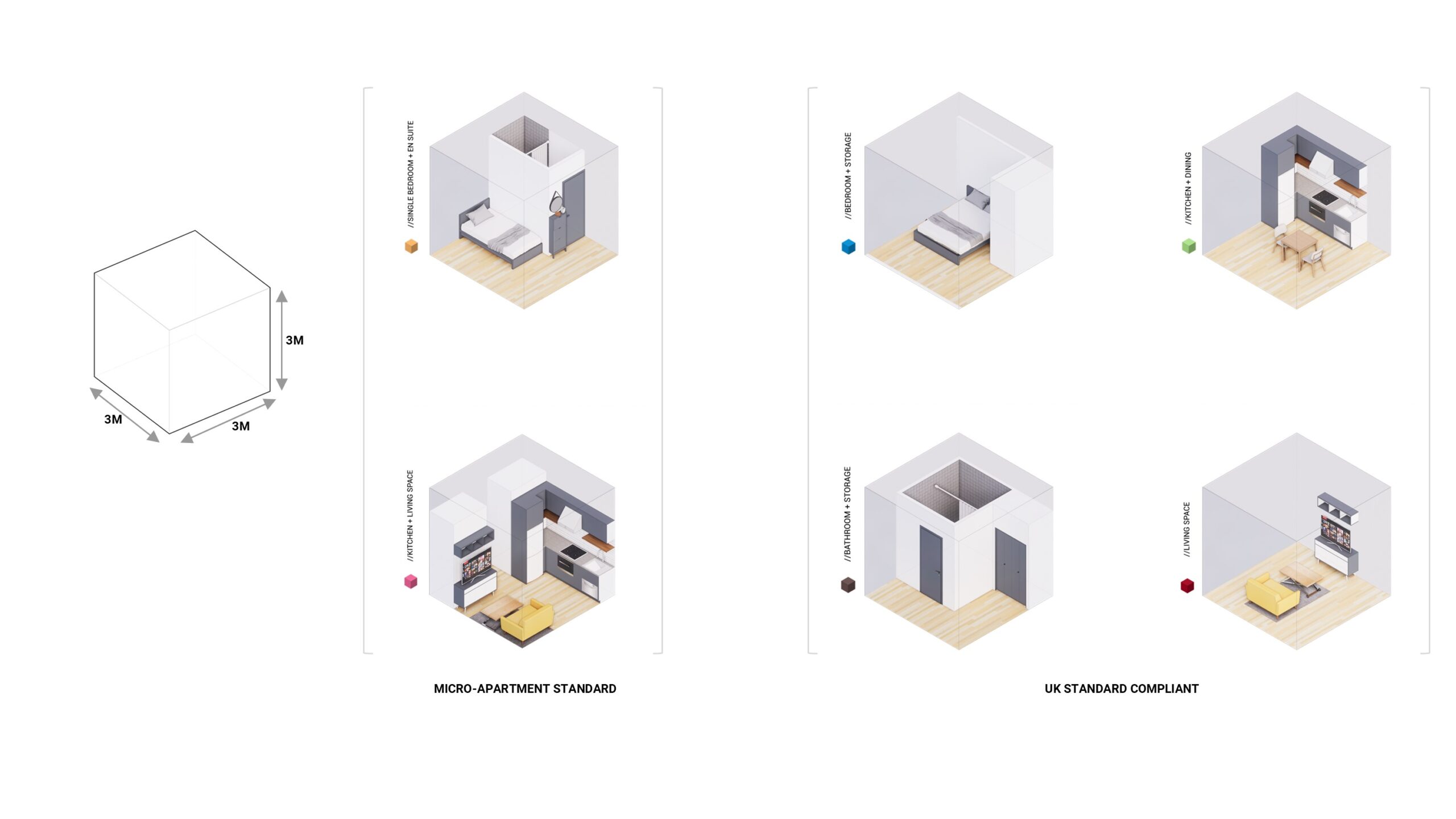
Apartment Modules
The room units, designed with discrete joining rules, provide an almost limitless potential for configurations, offering a highly flexible approach to architectural design. Each unit—whether a kitchen, living room, bedroom, or bathroom—comes with specific connection points that define how it can attach to other modules, allowing for diverse arrangements.
This modular system supports countless combinations, from simple linear sequences to complex multi-level structures, adapting to different needs and site constraints. The room modules’ discrete connections allow them to be easily reconfigured, expanded, or reduced, providing adaptability over time. This flexibility means the same set of modules can create various unique environments.
Specifically, graph-grammar aggregation was implemented to create the apartment modules. Graph-grammar allows for explicit definition of relationships between units, allowing us to control how units come together and which connections remain exposed for future aggregation or smart attribute placement.
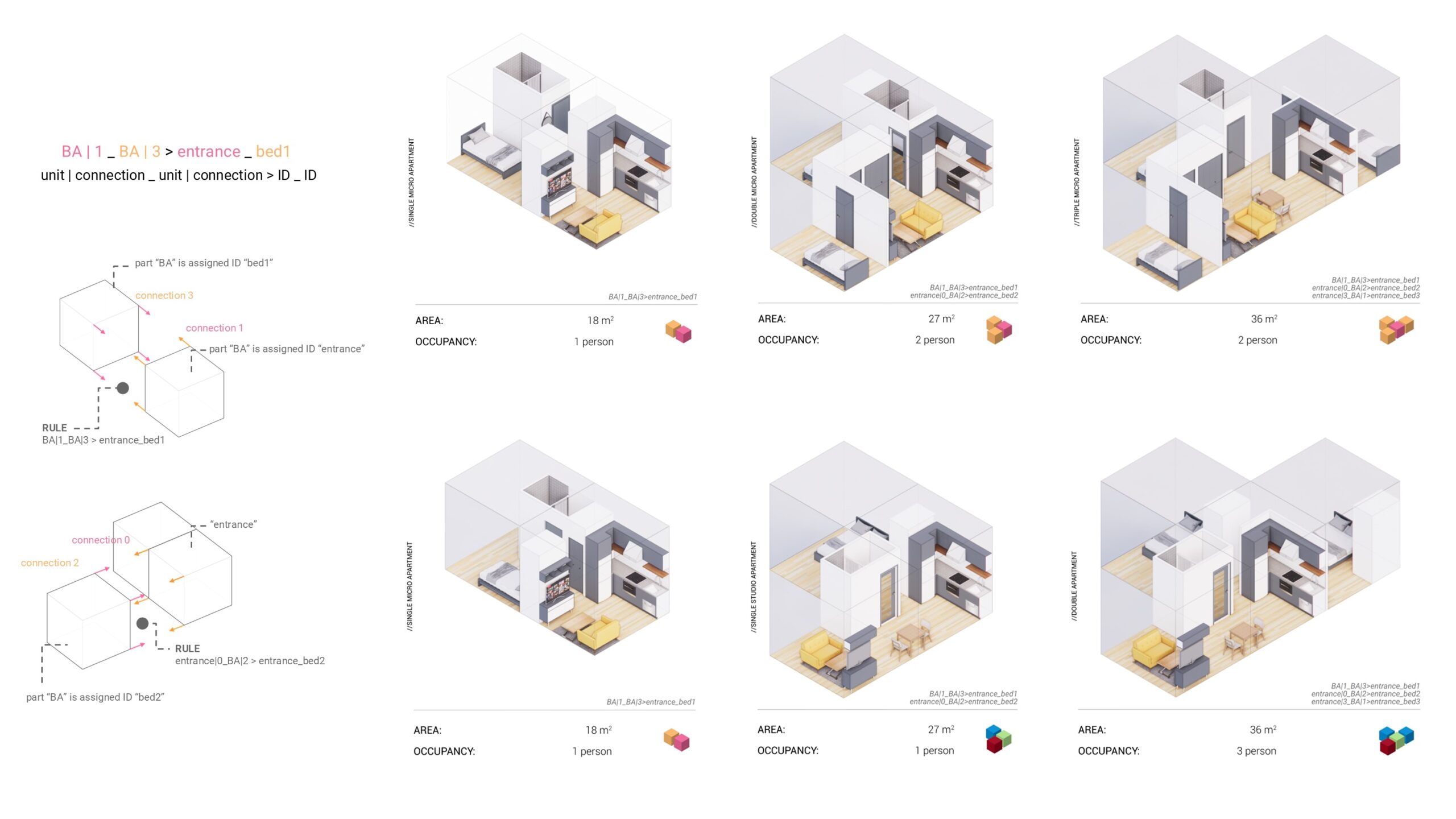
Field Conditions
The massing volume of the building is informed by a three-dimensional scalar voxel field. Multiple field values are analyzed for each point within the defined bounding box including context-sensitive environmental simulation. These field values are weighted and summed together to create a single combined matrix of field values used in the massing aggregation of discrete units. As explained earlier, OSM and geometric mathematics based on proximity creates the urban fields conditions. Ladybug and Honeybee plug-ins provide site specific environmental field conditions.
Wasp’s field-driven aggregation method uses the voxel field as a probability distribution to drive the aggregation process. The first part in the aggregation is placed at the voxel with the highest available value while the subsequent new parts are added at the next highest values reachable without breaking the aggregation continuity (Rossi, 2023).
In our workflow, the combined field values determine the start and direction of the massing aggregation; therefore, we effectively guide unit placement as expressed in a top-down methodology. This field-driven aggregation algorithm is inherently deterministic unlike stochastic aggregation.
Theoretically, any analysis can be transformed into a field, should it be relevant to the project. Graph mapper is implemented to remap field values into a 0-1 domain. These various matrices can be parametrically weighted or prioritized and determined by the end-user. Utilizing fields in this performance-driven way means there are countless different value combinations which would yield unique massing volumes. Finally, the weights and scaling values could be implemented within a genetic evolutionary solver to optimize the massing for a specific input parameter.
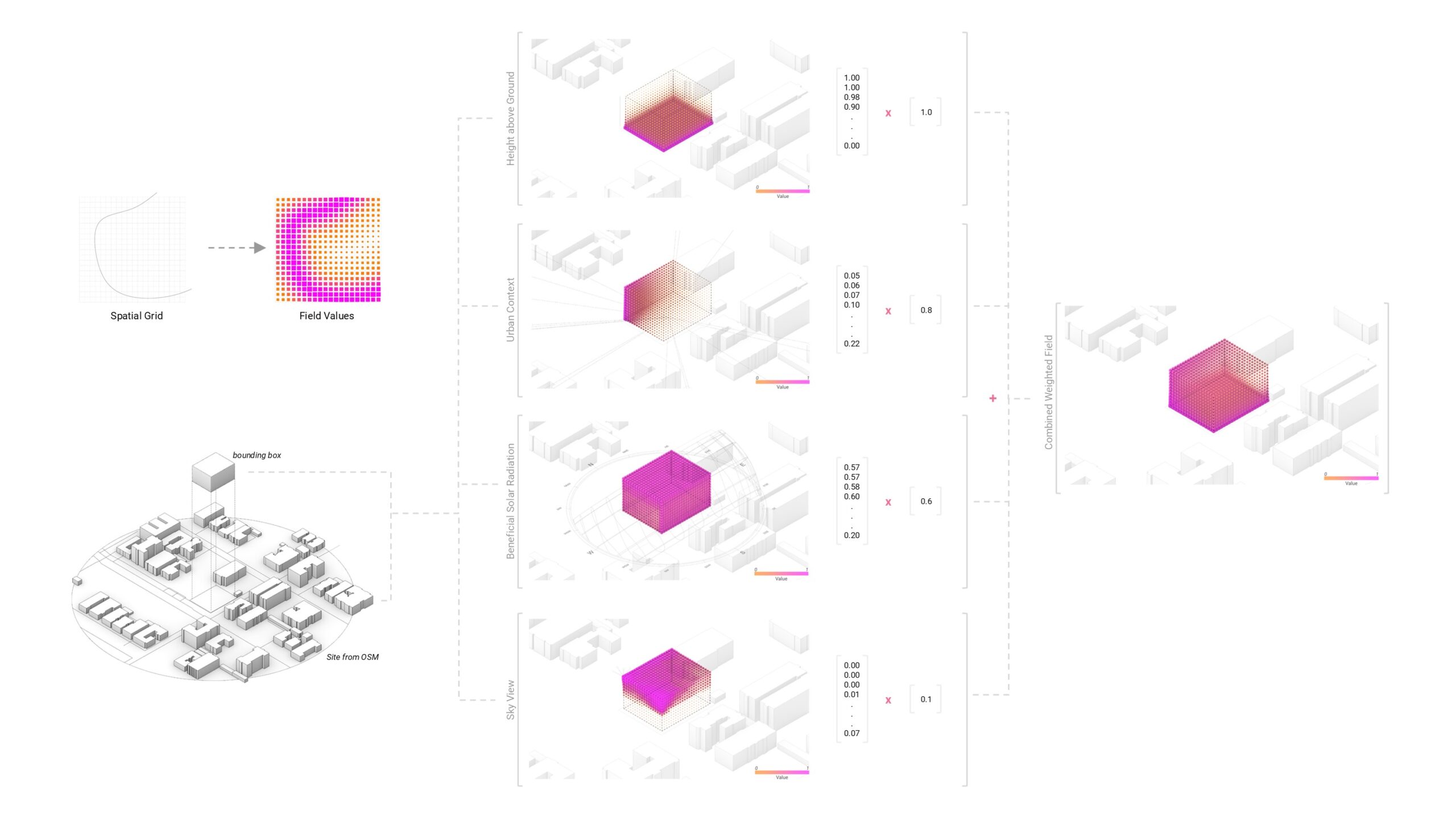
Massing Aggregation
With the Wasp field established, we first aggregate a ground floor mass using the base 3m x 3m unit. Next, utilizing an adjacency constraint as well as orientation constraint in world z-direction, we are able to aggregate a full building mass on top of the ground level. These aggregations are sequential and are field-driven while ensuring that the modular elements are always stacked and preventing cantilevered units. The script allows the designer to specify the number of units to aggregate on both the ground floor and massing volume above. This adds another dimension in the potential design space for massing shapes. Additionally, the number of units aggregated during the initial ground level aggregation determines whether the building is a solid rectangle, a rectangle with a courtyard, L-shaped, or U-shaped.
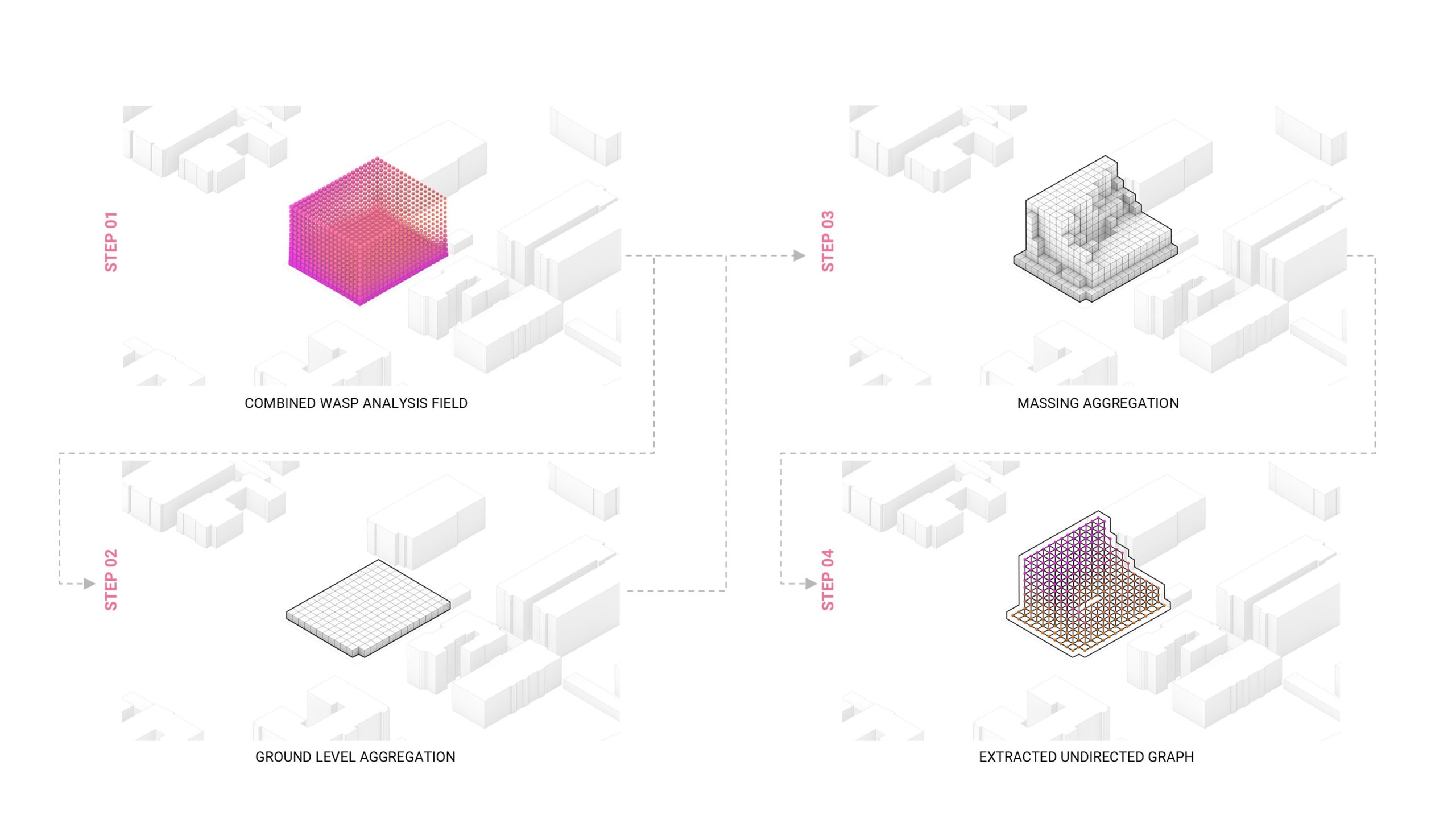
Vertical Circulation
Fire safety in residential multistory buildings is essential due to the high density of occupants and the complexity of evacuation scenarios. To ensure safe and efficient egress during a fire emergency, careful planning of vertical escape routes, or cores, is necessary. These cores, which include staircases and fire-protected elevators, must be strategically positioned to optimize evacuation effectiveness. The number of cores needed and their spacing are critical factors, as they directly influence how quickly occupants can reach an exit. Typically, cores should be placed to minimize travel distances, ideally within 30-45 meters, and spaced at least 45 degrees apart to provide multiple escape options in case one route becomes compromised. To analyze the requirements for core placement in our generated building mass, we have developed a workflow that uses graph theory and Lloyd’s algorithm to define catchment areas for different fire zones and optimal core positions.
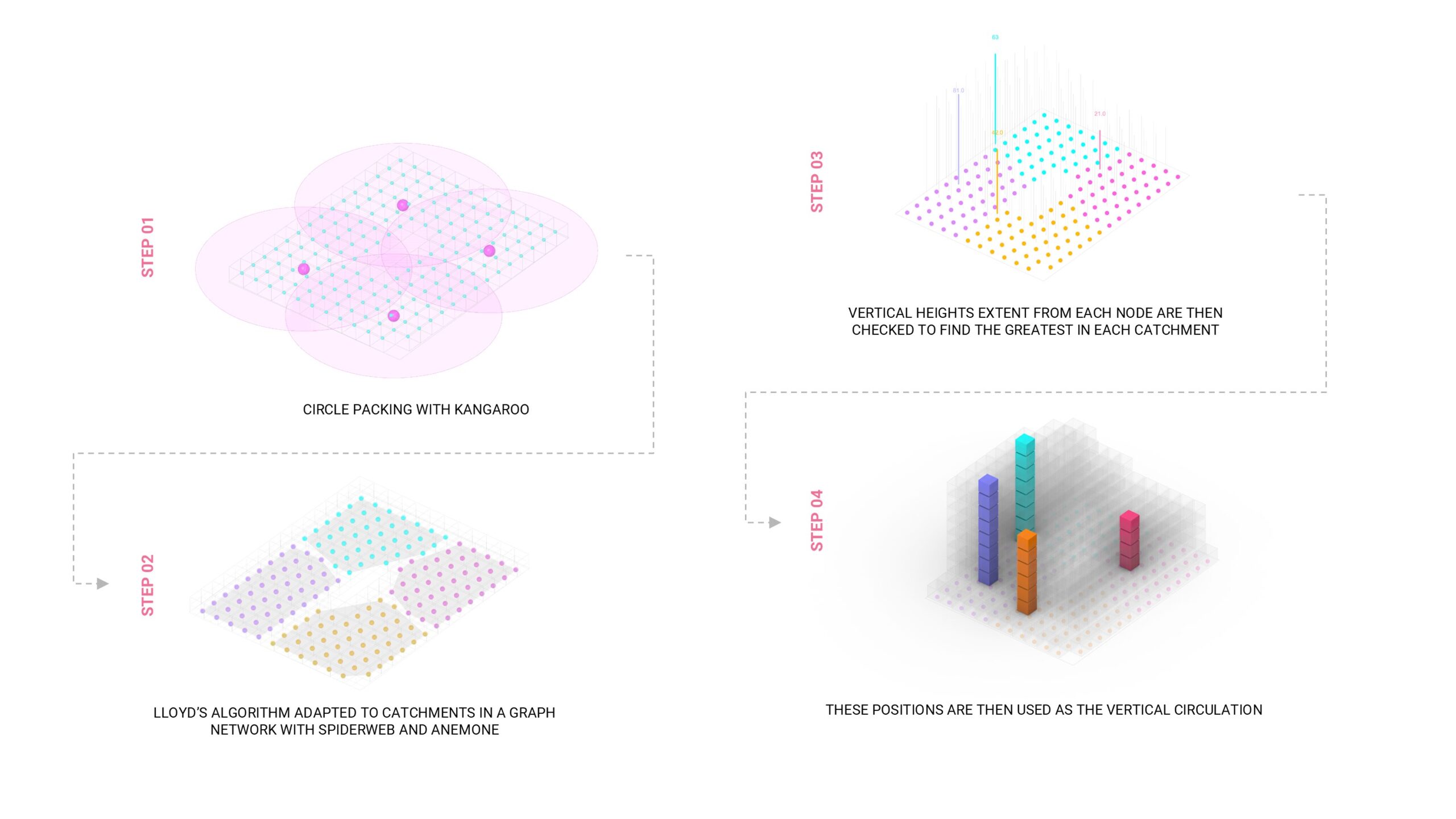
Horizontal Circulation
The automatic generation of building layouts has advanced significantly, yet generating complex, multi-storey buildings remains a major challenge. Current generative design methods often fail to account for efficient multi-level circulation and vertical connectivity, which are essential for functional and realistic building designs. Marcinkeviciute and Jabi (2023) have emphasized these limitations, noting that existing tools primarily cater to simpler, single-storey layouts. The paper suggests the gap requires an innovative approach that can dynamically optimize multi-level circulation and spatial relationships, enabling more feasible and coherent designs for complex, multi-storey buildings.
Our approach seeks to address this by leveraging graph theory to optimize circulation in more complex building typologies. While the path in simpler forms like courtyards can be easily offset to provide real estate along external boundaries, more intricate shapes such as L and U configurations present greater challenges in maintaining logical circulation and spatial coherence. The diagram on the right shows the step-by-step process of the algorithm for one floor plate.
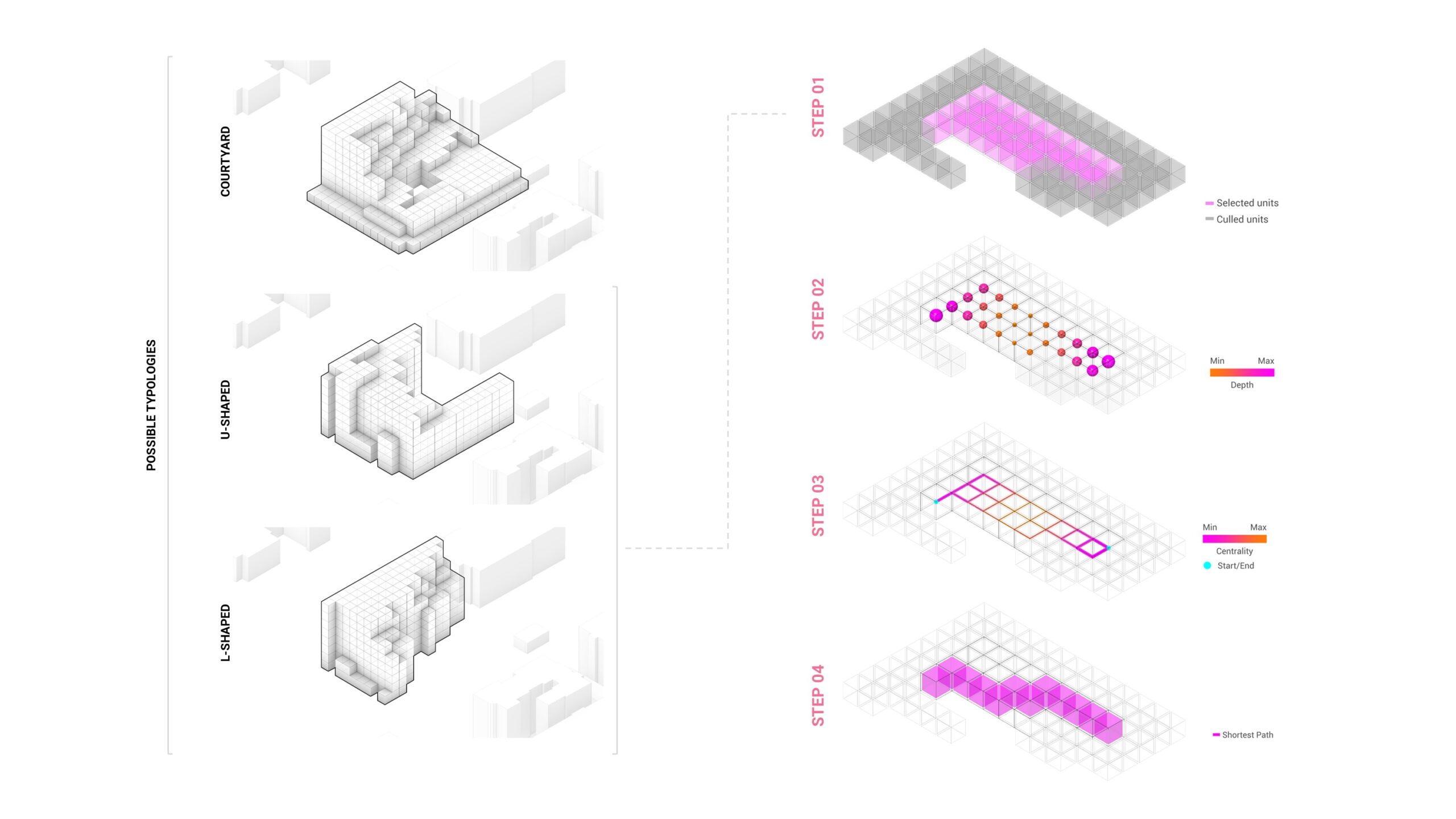
Completed Circulation Graph
Once the vertical and horizontal circulation is generated, a final process uses the shortest path algorithm to connect the two networks. The result is displayed below.
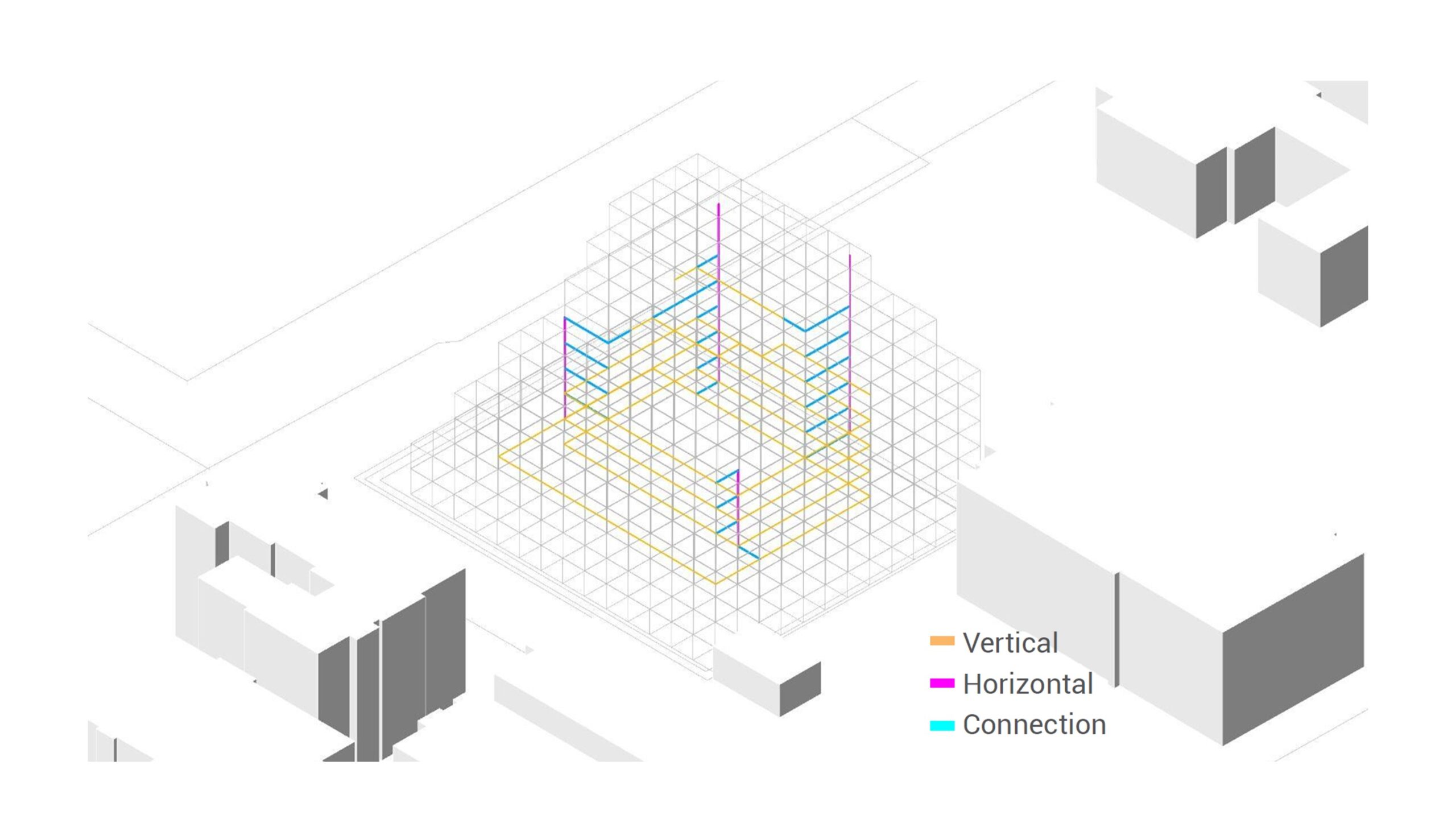
Floor Layout Aggregation
Once circulation is defined, we perform a final field-driven aggregation utilizing the apartment modules and text-based rules. Each floor layout is generated one floor at a time to ensure the user can control the mixture of apartment quantities per floor. The units generated in the first set of massing aggregations are culled and isolated through a custom workflow that follows the circulation route. These units input serve as previous Wasp “parts”, ensuring the final aggregation starts in the correct spatial location and orientation. We utilize an adaptive Parts Catalog to proportionally control the number of apartments placed. Being adaptive, the logic will change the internal probabilities of each apartment type being aggregated. Interestingly, this parts catalog introduces some randomness into the otherwise deterministic field-driven aggregation. This results in slightly different layouts each time the script is initiated. Controlling the seed of a field-driven aggregation would be advantageous for this reason; however, with each iteration, this randomness adds architectural interest and a unique design for users.
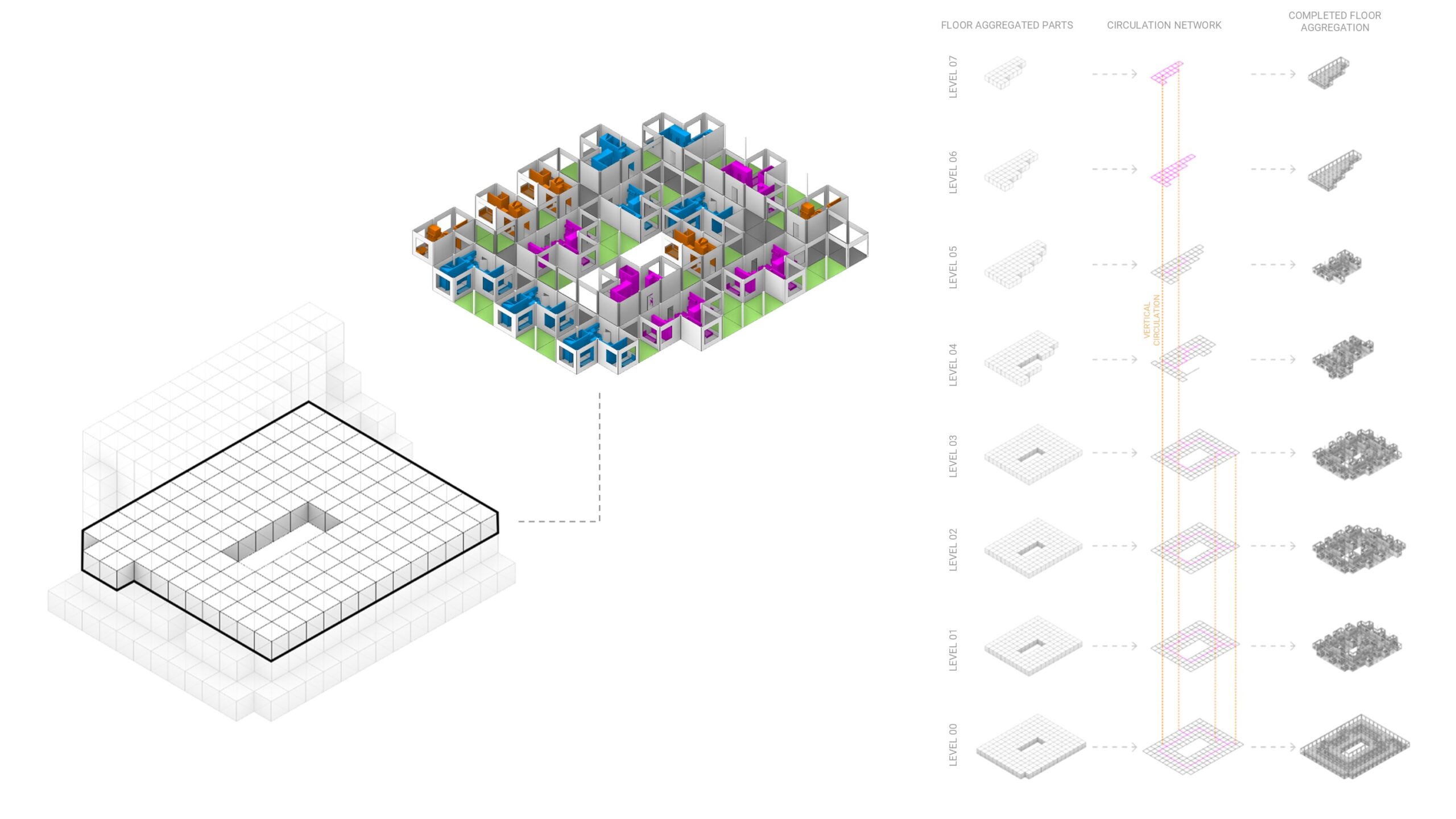
Wasp text rule syntax guide the floor layout aggregation. Rules are defined as a text string in the form A/a _ B/b, “where A and B are the type names of the two parts to aggregate, and a and b are the id of connections respectively of part A and B. Such rules specify the execution of a geometric transformation of module B’s geometry by orienting the plane connection b to match the orientation for the plane of connection a of module A. In this way, the two modules are positioned in space relatively to the positions of their connections. By sequentially applying different assembly rules over the already placed parts allows the growth of the aggregated structure” (Rossi, 2023).
Both the part geometry and connection IDs are exposed to build explicit relationships within the aggregated apartment modules and transitional “T” units. The connections developed during apartment module creation (refer to “Apartment Module” section) are important both for the text-rules and smart attribute logic, explained on the next page.
Wasp employs a two-step collider algorithm to place units and modules. First, a fast centroid proximity check analyzes all aggregated units. Then, a slower, mesh intersection check analyzes geometry within the collision distance (Rossi). We found that this algorithm, paired with pre-defined modules and restricted set of rules, may prevent each floor from full packing the available area. While this leads to less effective space use, these open node positions offer opportunity for common space including balconies; therefore, we embrace the distance between adjacent apartment modules – in later design, more support program could be added to maximize space utilization.
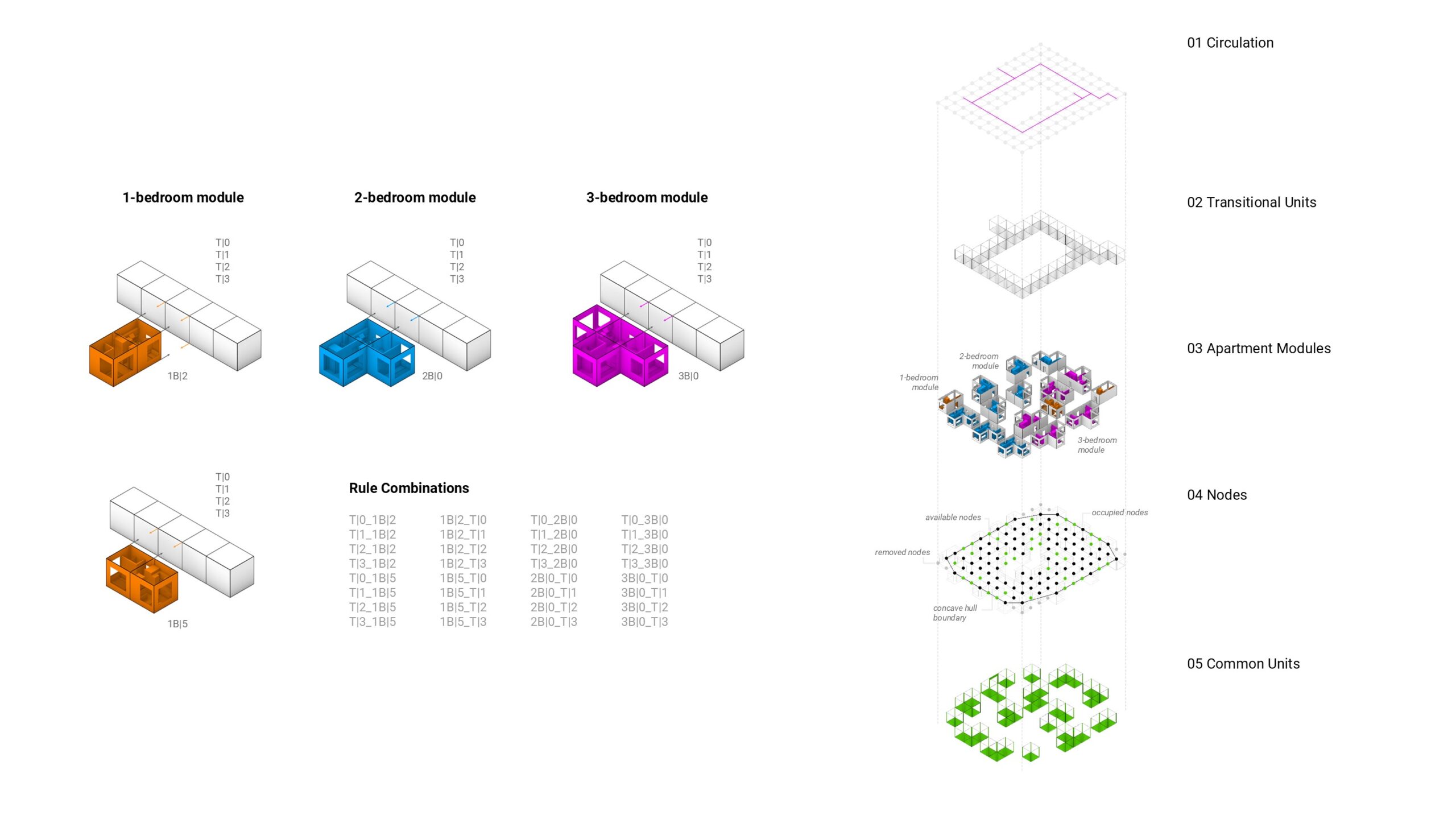
Smart Attributes
“In a combinatorial model, the parts are defined in the first step, but topology of the final assembly remains open during the whole design process… the definition of different levels of detail required in different phases can be shifted from the whole design to the design of the part itself” (Rossi, 2023). While the aggregation is performed on cube units and associated rules and connections, detailed mesh geometry is assigned during unit and module creation. Once aggregated, we extract the detailed geometry and create a higher level of detail (LOD) in the finished layouts. Within Wasp, we utilize simple attributes to model apartment furniture/equipment and smart attributes to simulate and generate a kit-of-parts wall paneling system as explained in the “Structural Grid and System” section of this paper.
The smart attribute logic is based on adjacency and exclusion rules which happens post-aggregation. Each apartment module connection understands its respective adjacency as either occupied (T) or free (F). We write a set of adjacency rules that filters the associated detailed geometry (kit-of-parts) to create an intelligent and responsive system. The geometry detailing is easily customizable and adaptable to whichever modular system kit-of-parts is being installed.
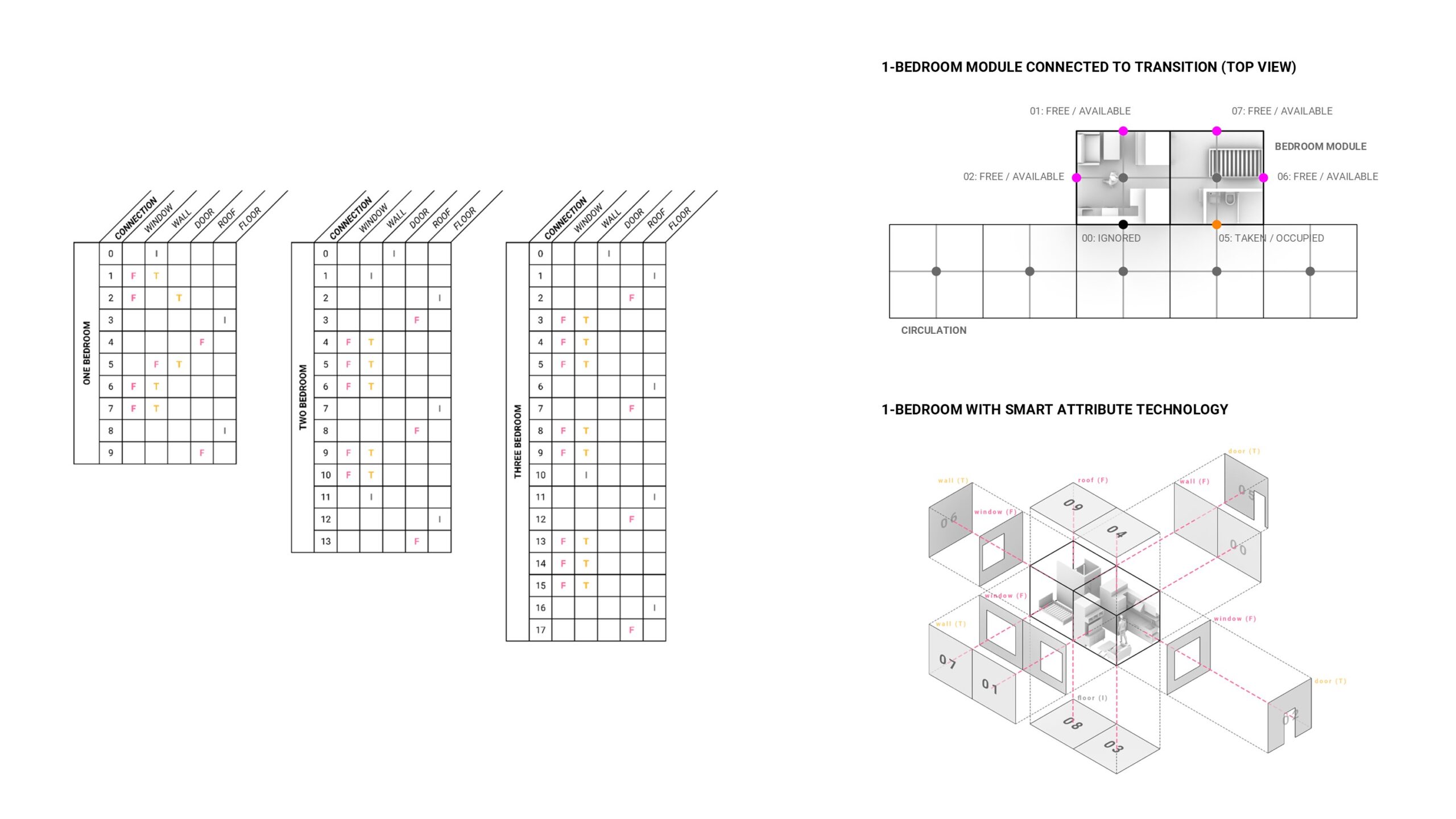
AI Visualization
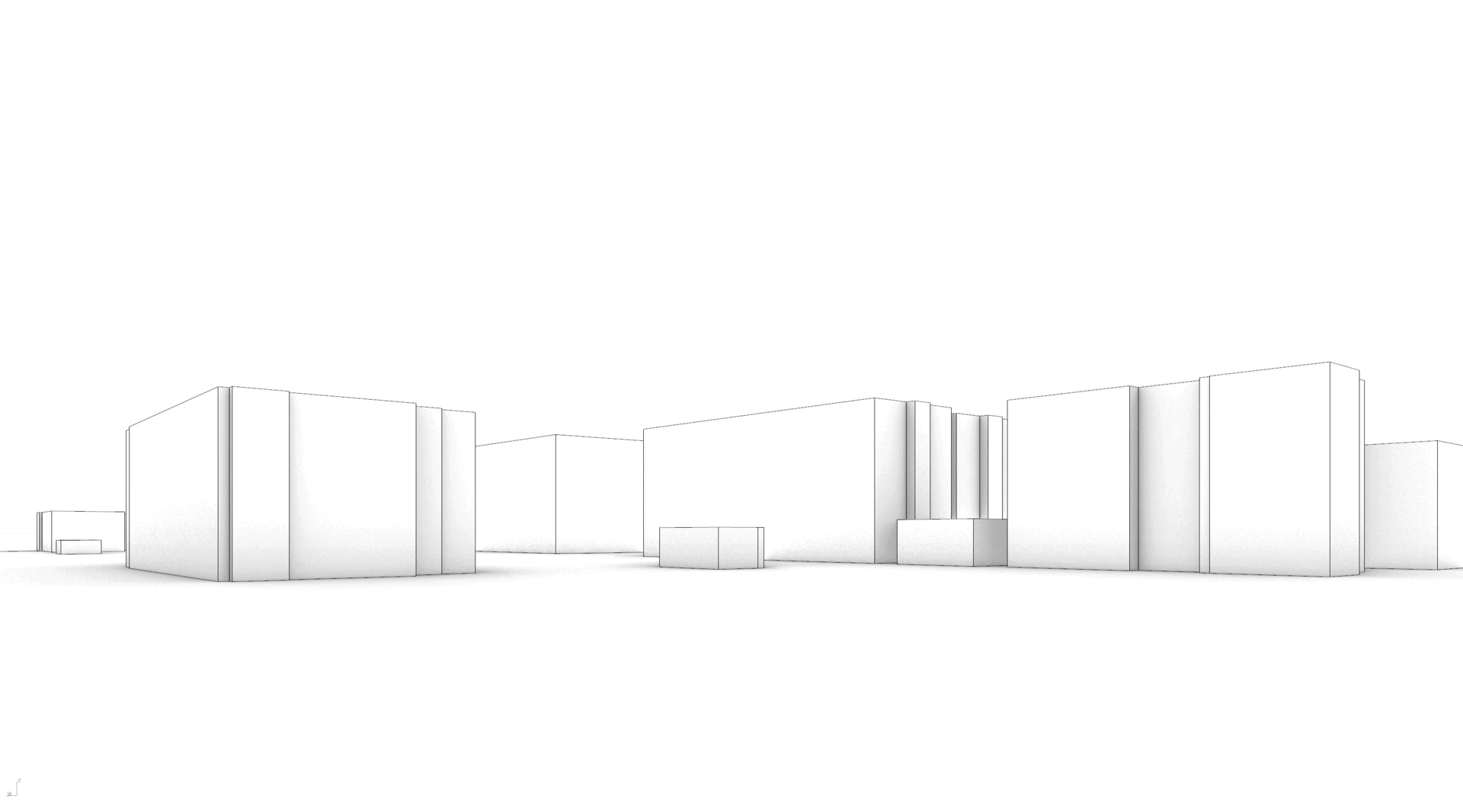
Finally, we render views of the completed building with facade attributes and context from Rhino. These images are used as input for a img2img generative AI workflow. We utilized Stable Diffusion, an open-source generative AI platform and ComfyUI which provides a graph-based visual scripting interface to Stable Diffusion. Specifically, we experimented with implementing Flux (flux1-dev model) and ControlNet with a MiDaS depth map. The ControlNet uses the input images from Rhino as a guide for the generative image. Various prompts and seeds can create countless image variations.
Most importantly, the goal of visualization is to leverage open-source generative AI for “good look” renders, giving users access to powerful AI processes with little need to understand the complexities of Stable Diffusion. The images would help organizations garner funding, make massing more realistic, or craft proposals for further design services.
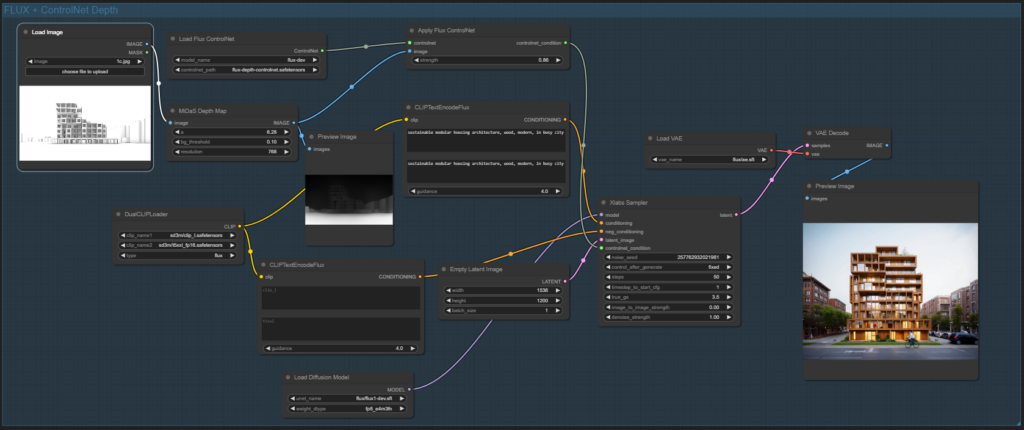
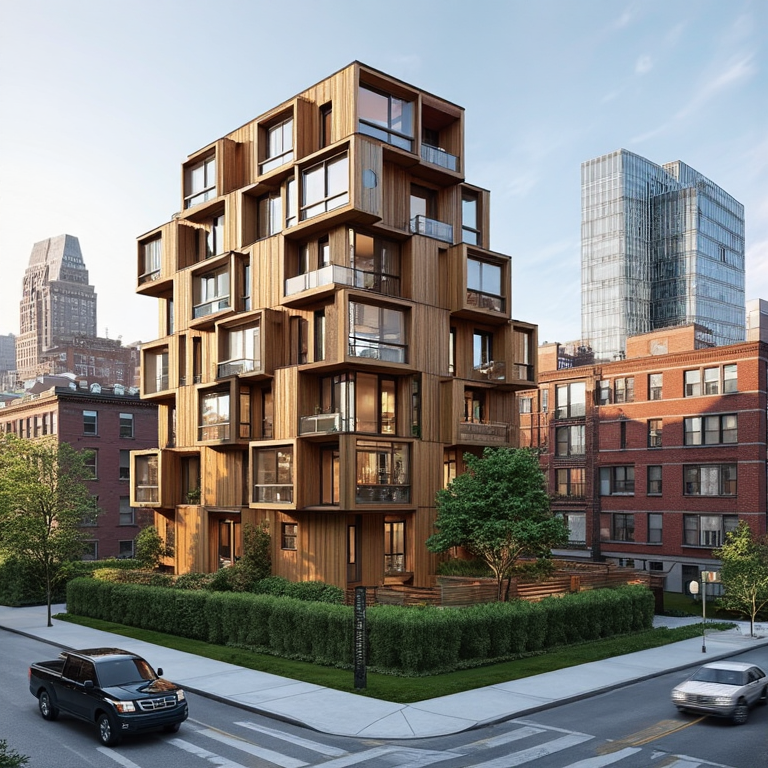
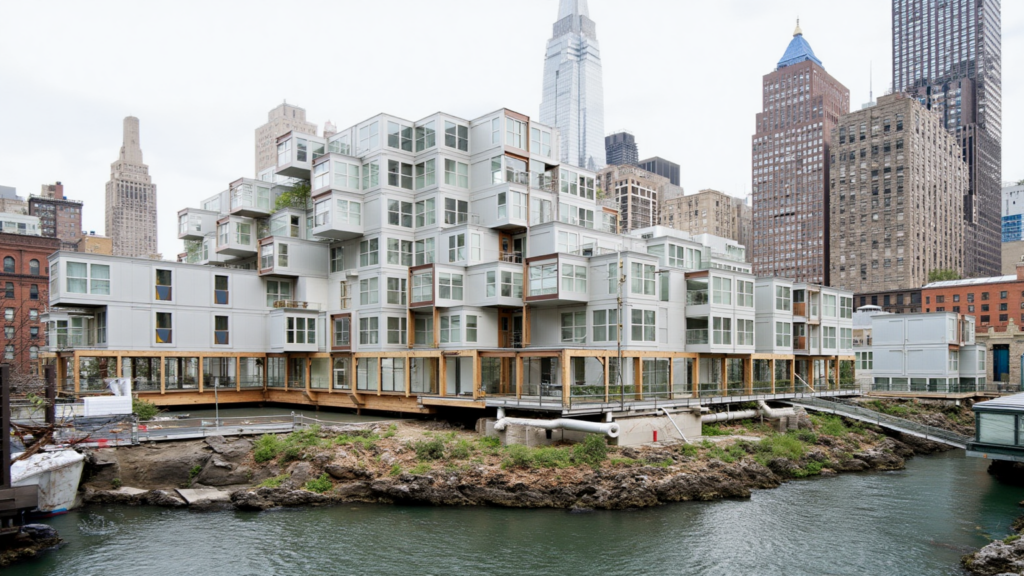
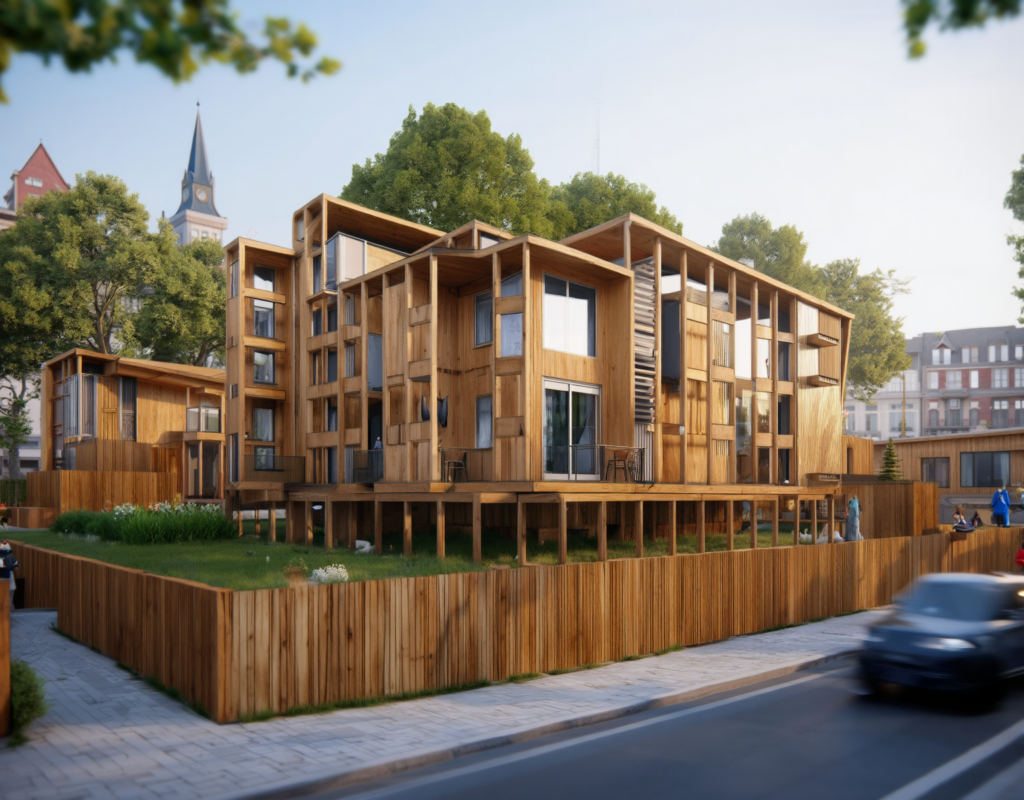
Web Application
Our web application, 3D3 (which stands for 3D Digital Democratized Design), serves as the user interface for digital participation. We developed a Vue app using three.js and node.js as our framework while RhinoCompute is leveraged to run our custom Grasshopper script on a cloud server. This gives users access to powerful computational tools and workflows like Rhino without needing the software or experience to build a custom script.
As it relates to participatory design, the web application has several key goals which helped guide development of the user experience. These goals include:
- Provide an intuitive sidebar and user controls
- Create visually clear interface and divisions
- Display relevant data in understandable way
- Utilize interactive 3D viewer
- Provide ability to customize location
- Facilitate rapid building massing iterations
- Visualize floor layouts and building volume
We utilize RhinoCompute as a cloud service to solve the logic remotely. Through Rhino3dm.js and the compatible 3dm Loader, we convert geometry to be rendered by three.js on the web; the web application framework employs vue3 and node.js. While we developed the web app, our script was tested locally using the Hops component.
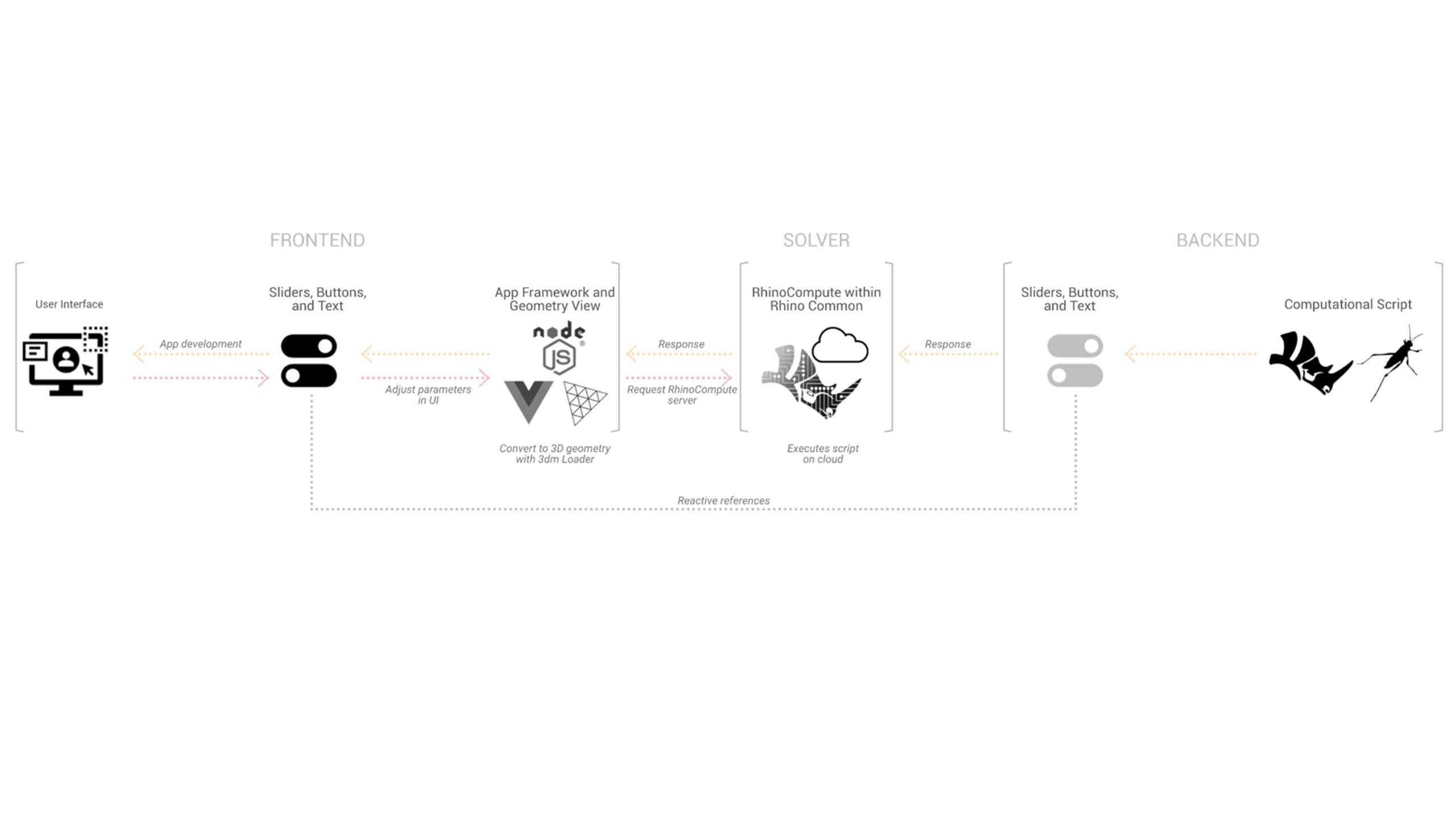
Reflection and Further Improvements
Our thesis demonstrates that by leveraging discrete combinatorial modeling and graph theory, we can automate context-based building generation. We introduce a novel workflow that combines top-down and bottom-up techniques, effectively blending contemporary architectural theories of field conditions and Object-Oriented Ontology (OOO). This approach shows that “discrete objects can maintain individual coherence while also existing within contingent, relational networks that condition their behavior” (Marcus, 2018). Within our computational framework, designers meld intuition with procedural and rule-based processes, embracing risk and unexpected outcomes.
Guided by Design for Manufacture and Assembly (DfMA) logic and modular construction principles, we designed unit and apartment modules. When aggregating and processing relationships between modular parts, graph theory proved instrumental in generating coherent buildings with effective circulation. Environmental simulations informed the building mass, placing performance metrics at the forefront of form generation. By applying spatial rules, modular attributes, and centrality metrics, our work contributes to the advancing field of building generation techniques.
We successfully made our computational process accessible through a web-based application to facilitate inclusive design. The intuitive user interface offers enough flexibility without causing confusion, making complex low-income modular building generation available to a wider audience. Feasibility metrics are displayed and update in real-time during design exploration, allowing users to make informed decisions.
Open-source design was both a goal and a vital component of our project. The open-source community enhanced our computational processes through shared expertise. Our script incorporates custom components developed by the community, such as the concave hull and shortest walk algorithms. Engagement with the Wasp Discord platform and communication with Andrea Rossi provided valuable support during development.
However, there are limitations in our thesis worth noting. Hops and RhinoCompute are stateless, complicating the execution of time-based scripts and user-initiated components within our Grasshopper file. This limitation restricted our ability to integrate evolutionary solvers like Galapagos or Wallacei. Additionally, the script operates within an inscribed rectangle on the selected site, which may not accommodate all building shapes. Reliance on a predefined 3×3 m base unit for aggregation also restricts flexibility, leading to inefficient circulation corridors and limited apartment layouts.
Opportunities for further development include:
- Computational Script: Enhance the combination and weighting of field conditions to prevent unrealistic massing. Refine circulation logic to account for all aggregation configurations and incorporate service riser placements for stacking utilities. Utilize smaller base units (e.g., 1.5 m × 1.5 m) for greater control and build a larger library of apartment modules for variety. Incorporate daylighting and thermal comfort analyses to provide performance-related data, aiding in optimization and reducing operational carbon. Embed embodied carbon analysis into the script and display it in the UI.
- Optimization: Implement evolutionary solvers or iterative workflows to find optimal solutions when aggregating units, making the design process more performance-driven. Explore machine learning and AI, such as using Graph Neural Networks (GNNs) to assign spaces or further subdivide floors, enhancing spatial relationships and metrics.
- Web Application: Record aggregated layouts for each floor and retrieve relevant geometry and metadata for use in the UI, possibly by storing information within the Vue application. Integrate rendering workflows like ComfyUI into the backend so users can generate high-quality renders directly from the UI. Provide improved analytics, such as estimated building and material costs, by connecting to relevant APIs.
Through this project, we demonstrate that discrete combinatorial modelling paired with graph theory can effectively automate building generation, bridging architectural theories and making advanced computational methods accessible to users. Despite the limitations, our work lays the groundwork for future developments in automated, performance-driven architectural design.
If you would like to view the full thesis document, please follow this link.
Bibliography
Allen, S. (2008). From Object to Field: Field Conditions in Architecture + Urbanism. In Practice: Architecture, Technique and Representation (2nd ed., pp. 216–243). Routledge.
Arcilla, P. (2015, February 24). New York to Complete First Prefabricated “Micro-Apartments” this Year. ArchDaily. https://www.archdaily.com/602157/new-york-to-complete-first-prefabricated-micro-apartments-this-summer
Arnstein, S. R. (1969). A Ladder Of Citizen Participation. Journal of the American Institute of Planners, 35(4), 216–224. https://doi.org/10.1080/01944366908977225
Arora, M. (2019, December 2). What is Open Source? Medium. https://mudit-arora.medium.com/what-is-open-source-5112e64eeda2
Bass, B., Curtis, L., New, J., Sanborn, S., & McNally, P. (2023). Universal design space exploration for building energy design. Journal of Building Engineering, 68, 105977. https://doi.org/10.1016/j.jobe.2023.105977
Behroozi, M. (2019). Largest Inscribed Rectangles in Geometric Convex Sets. https://doi.org/10.48550/arXiv.1905.13246
Brysch, S. L., & Czischke, D. (2022). Affordability through design: the role of building costs in collaborative housing. Housing Studies, 37(10), 1800–1820. https://doi.org/10.1080/02673037.2021.2009778
Bukovszki, V., Dóci, G., & Reith, A. (2021). Coding Engines in Participatory Social Housing Design—A Case to Revisit Pattern Languages. Sustainability, 13(6), 3367. https://doi.org/10.3390/su13063367
Chaillou, S. (2020). ArchiGAN: Artificial Intelligence x Architecture (P. F. Yuan, M. Xie, N. Leach, J. Yao, & X. Wang, Eds.; pp. 117–127). Springer Nature Singapore. https://doi.org/10.1007/978-981-15-6568-7_8
Chaillou, S., Dissen, H., Fure, H., & Landes, J. (2020, February 23). Architecture as a Graph. Medium. https://towardsdatascience.com/architecture-as-a-graph-6a835d46f918
Chang, K.-H., Cheng, C.-Y., Luo, J., Murata, S., Nourbakhsh, M., & Tsuji, Y. (2021). Building-GAN: Graph-Conditioned Architectural Volumetric Design Generation (No. arXiv:2104.13316). arXiv. https://doi.org/10.48550/arXiv.2104.13316
Chazelle, B. (1983). The Polygon Containment Problem. Advances in Computing Research, 1, 1–33.
Chou, R. (2022, March 22). Space Syntax: Urban Network & Spatial Relations. Data Mining the City 2022. https://medium.com/data-mining-the-city-2022/space-syntax-urban-network-spatial-relations-7679de91beb
Co-de-iT. (2024). Co-de-iT/Assembler. Co-de-iT. https://github.com/Co-de-iT/Assembler (Original work published 2021)
Colistra, J., & Vakil, N. (2020, January 1). Participatory Design in Housing.
Davies, G. (2013). The future of DfMA is the future of construction. Engineering Excellence Journal, 77.
Egor, G., Sven, S., Martin, D., & Reinhard, K. (2020). Computer-aided approach to public buildings floor plan generation. Magnetizing Floor Plan Generator. Procedia Manufacturing, 44, 132–139. https://doi.org/10.1016/j.promfg.2020.02.214
Flynn, K. (2018, April 4). Open Source for Everyone? Architect. https://www.architectmagazine.com/aia-architect/aiafuture/open-source-for-everyone_o
Garcia, T. (2010). Form and Object. Edinburgh University Press Ltd.
Ghannad, P., & Lee, Y. (2022). Automated modular housing design using a module configuration algorithm and a coupled generative adversarial network (CoGAN). Automation in Construction, 139, 104234. https://doi.org/10.1016/j.autcon.2022.104234
Green, M. (2017). Case for Tall Wood Buildings: Second Edition (2nd ed.). Blurb.
Guler, N. (2024, June 1). The Rise of Co Living in England: Planning Permission and Design Factors. Urbanist Architecture. https://urbanistarchitecture.co.uk/co-living-planning-permission/
Habitat for Humanity. (n.d.). The Affordable Housing Crisis in Developing Countries. Habitat for Humanity. Retrieved September 14, 2024, from https://www.habitat.org/emea/about/what-we-do/affordable-housing
Harman, G. (2022). Architecture and Objects. University of Minnesota Press.
Hernández, D. (2018, October 8). Homes for All – Dortheavej Residence / Bjarke Ingels Group. ArchDaily. https://www.archdaily.com/903495/homes-for-all-dortheavej-residence-bjarke-ingels-group
Hillier, B., & Hanson, J. (1984). The Social Logic of Space. Cambridge University Press.
Hinkle, L., Pavlak, G., Brown, N., & Curtis, L. (2022). Dynamic Subset Sensitivity Analysis For Design Exploration. 2022 Annual Modeling and Simulation Conference (ANNSIM), 581–592. https://doi.org/10.23919/ANNSIM55834.2022.9859293
Hu, R., Huang, Z., Tang, Y., van Kaick, O., Zhang, H., & Huang, H. (2020). Graph2Plan: Learning Floorplan Generation from Layout Graphs. ACM Transactions on Graphics, 39(4). https://doi.org/10.1145/3386569.3392391
Jabi, W. (2024). wassimj/Topologic. https://github.com/wassimj/Topologic (Original work published 2021)
Joshi, V. (2017, May 25). A Gentle Introduction To Graph Theory. Basecs. https://medium.com/basecs/a-gentle-introduction-to-graph-theory-77969829ead8
Lo, T. T., Schnabel, M. A., & Aydin, S. (2016, May 11). Modrule: A Gamified Design Communication Platform. 2016 Design Communication European Conference, Istanbul, Turkey.
Lo, T. T., Schnabel, M. A., & Gao, Y. (2015, January 1). ModRule: A user-centric mass housing design platform. 16th International CAAD Futures Conference, Sao Paulo, Brazil. https://doi.org/10.25455/wgtn.16417230.v1
London Housing Design Guide (Design For London). (2010). Mayor of London. https://www.london.gov.uk/sites/default/files/interim_london_housing_design_guide.pdf
Marcinkeviciute, D., & Jabi, W. (2023). Plausible Layout Generation Using Machine Learning, Evolutionary Optimisation and Parametric Methods (pp. 251–268). https://doi.org/10.1007/978-981-99-2217-8_14
Marcus, A. (2018). Go Figure: Between Object and Field. https://www.acsa-arch.org/chapter/go-figure-between-object-and-field/
Masterson, V. (2022, June 16). What has caused the global housing crisis – and how can we fix it? World Economic Forum. https://www.weforum.org/agenda/2022/06/how-to-fix-global-housing-crisis/
McKnight, J. (2016, April 6). Alejandro Aravena releases housing designs for free. Dezeen. https://www.dezeen.com/2016/04/06/alejandro-aravena-elemental-social-housing-designs-architecture-open-source-pritzker/
Merin, G. (2013, July 10). AD Classics: The Plug-In City / Peter Cook, Archigram. ArchDaily. https://www.archdaily.com/399329/ad-classics-the-plug-in-city-peter-cook-archigram
Merin, G. (2023, February 9). Architecture Classics: Habitat 67 / Safdie Architects. ArchDaily. https://www.archdaily.com/404803/ad-classics-habitat-67-moshe-safdie
Meuser, P. (2020). Construction and Design Manual Prefabricated Housing: Construction and Design Manual (2nd ed.). Dom Publishers.
Myung, J., Lee, T., & Choi, J. (2022). Approaches to Affordable Housing Design Using VAE and Space Syntax: Case Studies from Los Angeles. Resilient City. ARCC-EAAE 2022 International Conference.
Nauata, N., Chang, K.-H., Cheng, C.-Y., Mori, G., & Furukawa, Y. (2020). House-GAN: Relational Generative Adversarial Networks for Graph-constrained House Layout Generation (No. arXiv:2003.06988). arXiv. https://doi.org/10.48550/arXiv.2003.06988
Nauata, N., Hosseini, S., Chang, K.-H., Chu, H., Cheng, C.-Y., & Furukawa, Y. (2021). House-GAN++: Generative Adversarial Layout Refinement Networks (No. arXiv:2103.02574; Version 1). arXiv. https://doi.org/10.48550/arXiv.2103.02574
Ng, P., Li, Y., Zhu, S., Xu, B., & van Ameijde, J. (2023). Digital common(s): the role of digital gamification in participatory design for the planning of high-density housing estates. Frontiers in Virtual Reality, 3. https://doi.org/10.3389/frvir.2022.1062336
Pereira, M. (2020, March 3). Under 30m2: Multifunctional Solutions in 13 Tiny Apartments. ArchDaily. https://www.archdaily.com/934616/under-30m2-multifunctional-solutions-in-13-tiny-apartments
Quinta Monroy housing, Iquique – Alejandro Aravena ELEMENTAL. (n.d.). Arquitectura Viva. Retrieved September 14, 2024, from https://arquitecturaviva.com/works/viviendas-quinta-monroy-1
Raymond, E. S. (2023). Open source | Definition, Hacker Culture & Linux | Britannica. In Britannica. https://www.britannica.com/topic/open-source
Robinson, J. (2006). Architecture of Institution & Home. Architecture as Cultural Medium.
Rossi, A. (2021). Wasp v0.4.013: Discrete Design for Grasshopper. https://github.com/ar0551/Wasp (Original work published 2017)
Rossi, A. (2023). Mediated Assemblies: An Open Source Software Approach to Combinatorial Design and Fabrication [Ph.D. Thesis, Technische Universität Darmstadt]. https://doi.org/10.26083/tuprints-00024039
Shah, A. (2018). Design Council’s response to the Social Housing Green Paper. Design Council. https://www.designcouncil.org.uk/our-resources/archive/reports-resources/design-council-s-response-social-housing-green-paper/
Slingerland, G., Murray, M., Lukosch, S., McCarthy, J., & Brazier, F. (2022). Participatory Design Going Digital: Challenges and Opportunities for Distributed Place-Making. Computer Supported Cooperative Work (CSCW), 31(4), 669–700. https://doi.org/10.1007/s10606-022-09438-3
Sookhoo, D., Lynam, A., Buchanan, K., & Haward, M. (2023). Co-producing affordable housing futures: tools for community participation. Arq: Architectural Research Quarterly, 27(3), 268–277. https://doi.org/10.1017/S1359135523000192
Subdigital. (2021). Monoceros. Project Monoceros. https://monoceros.sub.digital
Teaching: Aggregation and Graph-Based Modelling. (2017, April). https://www.behance.net/gallery/51660335/Teaching-Aggregation-and-Graph-Based-Modelling
Technical housing standards – nationally described space standard. (2024, March 15). GOV.UK. https://www.gov.uk/government/publications/technical-housing-standards-nationally-described-space-standard
The Building Regulations 2010, Fire Safety: Approved Document B. (2019). RIBA Books.
Thomsen, J. (2007). Home Experiences in Student Housing: About Institutional Character and Temporary Homes. Journal of Youth Studies – J YOUTH STUD, 10, 577–596. https://doi.org/10.1080/13676260701582062
United Nations. (2023, October 20). UN expert urges action to end global affordable housing crisis. OHCHR. https://www.ohchr.org/en/press-releases/2023/10/un-expert-urges-action-end-global-affordable-housing-crisis
Weber, R., Mueller, C., & Reinhart, C. (2022). Automated floorplan generation in architectural design: A review of methods and applications. Automation in Construction, 140, 104385. https://doi.org/10.1016/j.autcon.2022.104385
Weber, R., Mueller, C., & Reinhart, C. (2024). A hypergraph model shows the carbon reduction potential of effective space use in housing. https://doi.org/10.21203/rs.3.rs-4277811/v1
Wilson, J. (2023). Design for Modular Construction: An Introduction for Architects. The American Institute of Architects.
World Green Building Council. (2022). Sustainable and Affordable Housing Report. World Green Building Council. https://worldgbc.org/article/sustainable-and-affordable-housing/
Zhong, X., Yu, F., & Xu, B. (2023). A Human–Machine Collaborative Building Spatial Layout Workflow Based on Spatial Adjacency Simulation. In P. F. Yuan, H. Chai, C. Yan, K. Li, & T. Sun (Eds.), Hybrid Intelligence (pp. 14–24). Springer Nature. https://doi.org/10.1007/978-981-19-8637-6_2

